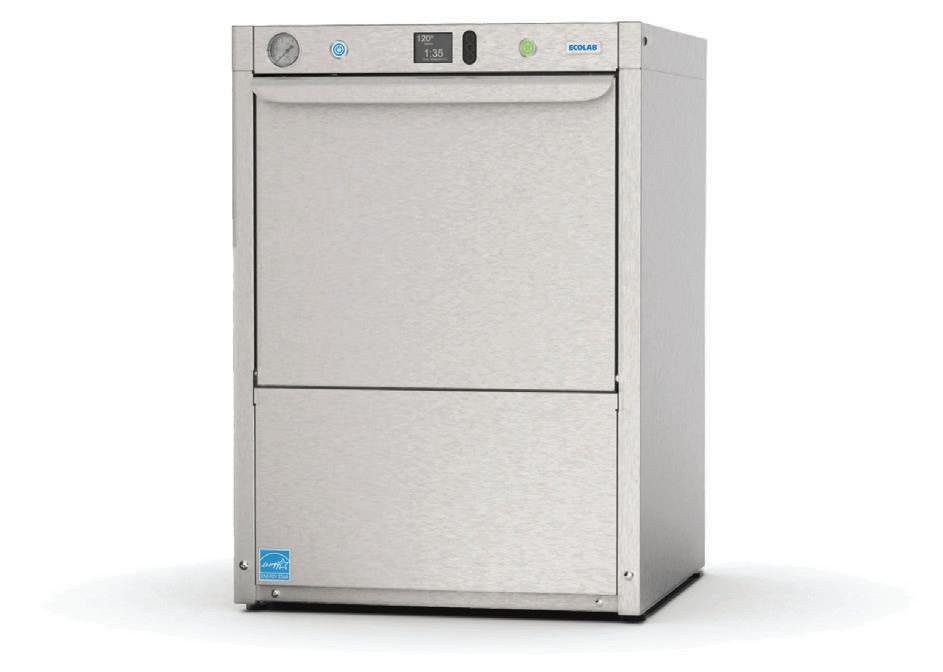




























































Our exceptional line of stand-up bags make it more convenient to prepare desserts and beverages with premium Ghirardelli Chocolate.

CONVENIENT Smaller bags are easy to pour and store.
ACCESSIBLE Flexible offerings let you mix and match different chocolate varieties.
VERSATILE Couverture chocolate formats are perfect for flavoring, coating, melting, and glazing. Non-couverture chips hold up well when baked.
Explore the new line and request your samples today.*




18
FRANCHISE FORWARD
FroYo’s Second Act
Leading brands are evolving. BY CALLIE EVERGREEN

42
OPERATIONS
A Shifting Paradigm
DEI isn’t just corporate speak— it’s part of the retention equation.
BY BRYAN REESMAN
44
CLIMATE RESPONSIBILITY
Good to Go on Food Waste
A growing app looks to empower restaurants on a vital topic.
BY ISABELLA SHERK13
FRESH IDEAS
The Convenience Battleground
Can C-stores compete with quick-service restaurants?
 BY
BY
16
ISABELLA SHERK
ONES TO WATCH
Cookie Plug
An o beat brand is ready to turn a red-hot category on its head. BY BEN COLEY


40
OUTSIDE INSIGHTS

The Next Wave of On-Demand Delivery
Ghost kitchens are learning from the successes of predecessors.
BY LIZ MOSKOW
50
START TO FINISH
Tom Sterrett
The president and CEO of D’Angelo Grilled Sandwiches on the path ahead.
in the Box CEO Darin Harris has led a major turnaround at the legacy concept.

EDITORIAL DIRECTOR
Danny Klein dklein@wtwhmedia.com
MANAGING EDITOR
Nicole Duncan nduncan@wtwhmedia.com
SENIOR EDITOR
Ben Coley bcoley@wtwhmedia.com
SENIOR EDITOR Callie Evergreen cevergreen@wtwhmedia.com
CUSTOM MEDIA STUDIO
Running a quick-service restaurant in any economic environment is a challenge. Being faced with the headwinds












operators see today, like inflation, labor challenges, and a potential recession, only ups the ante.

The good news? You don’t have to go it alone. The vendors who have chosen to participate in this section take pride in the solutions they’ve created for quick serves, and they’re eager to connect and help out.
DIRECTOR OF CUSTOM CONTENT Peggy Carouthers pcarouthers@wtwhmedia.com
ASSOCIATE EDITOR, CUSTOM CONTENT Charlie Pogacar cpogacar@wtwhmedia.com
ASSOCIATE EDITOR, CUSTOM CONTENT Kara Phelps kphelps@wtwhmedia.com

ART & PRODUCTION
ART DIRECTOR Tory Bartelt tbartelt@wtwhmedia.com
GRAPHIC DESIGNER Erica Naftolowitz enaftolowitz@wtwhmedia.com
PRODUCTION MANAGER
Mitch Avery mavery@wtwhmedia.com
ADOBE STOCK: F8 SUPORT UKRAINE 4 JANUARY2023 | QSR | www.qsrmagazine.com
SALES & BUSINESS
DEVELOPMENT
GROUP PUBLISHER

Greg Sanders gsanders@wtwhmedia.com
NATIONAL SALES DIRECTOR Eugene Drezner edrezner@wtwhmedia.com 919-945-0705
NATIONAL SALES MANAGER





Edward Richards erichards@wtwhmedia.com 919-945-0714
NATIONAL SALES MANAGER Amber Dobsovic adobsovic@wtwhmedia.com 919-945-0712
NATIONAL SALES MANAGER John Krueger jkrueger@wtwhmedia.com 919-945-0728
SALES SUPPORT AND DIRECTORY SALES Tracy Doubts tdoubts@wtwhmedia.com 919-945-0704

FOUNDER Webb C. Howell
ADMINISTRATION


919-945-0704 / www.qsrmagazine.com/subscribe
QSR is provided without charge upon request to individuals residing in the U.S. who meet subscription criteria as set forth by the publisher.

REPRINTS


The YGS Group 800-290-5460
FAX: 717-825-2150 qsrmagazine@theygsgroup.com www.qsrmagazine.com/reprints
HOSPITALITY, AND FOOD GROUP 52 How Quick-Service Restaurants Can Elevate the Self-Ordering Experience SPONSORED BY ACRELEC 54 Why Digital Orders Need a Chain of Digital Custody SPONSORED BY APEX ORDER PICKUP SOLUTIONS 56 This Automated Beverage Program Helps Restaurants Regain Lost Beverage Sales SPONSORED BY BOTRISTA 58 2023 Restaurant Mantra: Operational Efficiency SPONSORED BY INTELLIHOT 60 How Restaurants Are Solving 3 Big Challenges in 2023 SPONSORED BY LOOMIS US 62 How Restaurants Are Reducing Labor Cost While Improving Customer Service SPONSORED BY NAVIA ROBOTICS 64 Keep Your Head Above Water When Labor Costs Rise SPONSORED BY RESTAURANT TECHNOLOGIES 66 Why Operators Are Moving Toward Repair Plans SPONSORED BY R.F. TECHNOLOGIES, INC. 68 How to Maximize Restaurant Efficiency with the Internet of Things SPONSORED BY WELBILT 70 The End-to-End Solution that Will Increase Drive-Thru Velocity and Sales SPONSORED BY XENIAL 51 Restaurant Equipment & Technology / January 2023 As restaurants continue to combat new challenges, here are some of the companies and vendors o ering solutions. 52 ACRELEC 54 APEX ORDER PICKUP SOLUTIONS 56 BOTRISTA 58 INTELLIHOT 60 LOOMIS US 62 NAVIA ROBOTICS 64 RESTAURANT TECHNOLOGIES 66 R.F. TECHNOLOGIES, INC. 68 WELBILT 70 XENIAL Restaurant Equipment & Technology Old wisdom has noted that the restaurant industry was slow to adapt to certain technologies. digitization of, well, everything steady process playing during equipment, technology, digital furious, helping JANUARY / 2023
Sponsored content in this magazine is provided to the represented company for a fee. Such content is written to be informational and non-promotional. Comments welcomed at sponsoredcontent@qsrmagazine.com.


Texas Pete ® is taking its flavor on the road with convenient, easyto-enjoy portion control packets! Whether it’s a Texas Pete ® dip cup or sauce packet, your customers will be able to enjoy bold flavor for a better on-the-go dining experience—anywhere, at any time. Ask your broker for the #1 portion control hot sauce and request a free sample today!









As always this time of the year, conversations have turned to the future. Personally, I’m not a big resolutions fan. It doesn’t take me long to remember why I wasn’t doing something to begin with ( like jogging) But in terms of restaurants, I’ve been charting prediction pieces for close to a decade. And as you might imagine, the first several years were tame in comparison to the past few. We’ve gone from themes like delivery and plant-based to trying to sort a revolution. This year, I crowdsourced some thoughts from Linkedin. Here were some replies:
Mark Moeller, a national restaurant consultant, believes the word of 2023 will be “transparency.” In his view: “As a guest we want to know where our food is coming from, we want to know that the team is being treated fairly and ethically, we want to know if the restaurant owner is truly invested in the community they serve.” The same, Moeller goes on, applies to employees believing their company’s ethos is more than lip service, as well as investors backing brands with purpose.
Lena Katz, a content and creator strategy director at Ampersand, sees the convergence of AI/robotics and employees taking on a lasting form. Perhaps fewer employees, but better paid, and thus, tech that improves guest experience while maintaining a sustainable profit margin. One example she referenced was Which Wich’s YellowLab kiosks—an innovative spin that allows remote workers ( or virtual cashiers ) to run the system.
Restaurant coach and entrepreneur Bryan Meredith projects a labor shift. “When the Fed wins and unemployment goes up, the labor pool will get better for restaurants and the real decisions will




have to be made with respect to staffing needs versus the path to automation,” he said. “Restaurateurs must figure out this dynamic and get a clear focus on how they want to run their business.”
Megan Gibson, brands account executive at Restaurant365, feels improving margins ( on the mind of all ) starts with eliminating outdated systems that run your back office. Toss the Excel spreadsheets.

Dynamic speed of service and dynamic pricing? Both came up. On the former, VP of digital at HMSHost, Neil Thompson, projects flexible technology solutions that enable the guest to control the pace of their experience. Quickserves, he says, have become more about convenience than dine-in destinations.
Brittany Maroney, director of marketing and communications at PAR Technology, envisions more expansion for restaurants into loyalty, using data to personalize and integration into online ordering and contactless payment.
And lastly, is a shakeout in store? Mark Hutchings, who works with restaurants and bars at Statement Insurance Agency, believes so. “I see a new wave of closures in the post pandemic era. PPP and other programs that kept struggling locations afloat during the pandemic are winding down just as a recession is starting. At the same time, surviving operators may finally see some labor relief as layoffs hit other industries and underperforming restaurants close.” In my view, I think 2023 is a year of recalibration as innovation settles into application. From disruption to optimization, and beyond.
Danny Klein, Editorial Director


Looking ahead, restaurants will grapple with years of change, and applications that bring it all together.













Merch lines have become a common branding expression for quick-service chains.

The brand’s latest apparel collection took it up a notch.
AHEAD OF THE HOLIDAY SEASON, Panda Express teamed up with AAPI-owned community-driven streetwear brand, UPRISERS, to launch a limited-edition apparel collection called “Future Is Now.”

The full collection debuted at ComplexCon, but consumers and nonComplexCon attendees were able to shop a special early drop of four items (reversible bomber jacket, takeout pail purse, T-shirt, and air freshener pack).
Inspired by UPRISERS’ mantra, “what you wear is what you represent,” the collaboration looked to honor both brands’ cultural roots to collectively move forward as a community. Furthermore, 10 percent of proceeds from the UPRISERS x Panda Express collection were donated to the Filipino Migrant Center, furthering the company’s efforts to uplift AAPI voices and small businesses through its fundraising initiative.


new year brings
and some old and novel ideas on deck.Just like 2023, this coming calendar promises plenty of consumer-driven innovation ignited by technology. What’s to come? We check in with some experts.




Smaller footprint stores will emerge focused on off-premises strategies and rapid order pickup.
As consumer restaurant habits continue to shift away from in-store dining and mobile ordering becomes more prevalent, some restaurant brands have acquired real estate as well as off-premises technology solutions for new stores uniquely designed for mobile orders, curbside pickup, and the drive-thru. In lieu of in-store dining, we’ll see distributed, smaller footprint stores that offer a highly personalized customer experience and real estate optimized for order pickup, whether that’s dedicated mobile-only drive-thru lanes or curbside pickup spots. These initiatives will be further enhanced by automation such as AI voice ordering, reconfirming order details, and the like.
Fast-casual dining segments will become more popular.
Coming out of the pandemic, inflation will hit full-service restaurants heavily, and fast casual will trend higher in terms of dining experiences for consumers.


Consumers will gravitate toward the fast-casual restaurant market for its convenience and away from full-service and fine-dining experiences.
Competition in fast food heats up. Quick-service restaurants aren’t just competing with their rivals anymore; there’s growing competition between fast-food brands and stores that offer a faster, easier, or more engaging buying experience such as smaller footprint stores, coffee chains with shorter drive-thru lines, or convenience stores that continue to invest heavily in foodservice initiatives. Some fast-food customers are also lured away from quick-serves in search of healthier options, clean ingredients, or even environmentally friendly packaging that reduces the carbon footprint. In some cases, smaller restaurants may need to be more mission-driven and provide a healthier menu to compete.
Emil Davityan BLUEDOT COFOUNDER AND CEOMenu Re-Development. With rising inflation and the cost of goods at an all-time high for restaurants, virtually all restaurant operators are looking at re-engineering their menus to find unique and creative ways to be able to provide perceived value to the guest in terms of menu items, while tweaking or changing the ingredients used and the portion sizes. I also believe we will see price increases across the board in all sectors of the dining industry to offset these rising costs.
KingConsumers are slowly moving away from takeout and delivery and are starting to enjoy more meals at brick-and-mortar stores. During the COVID-19 pandemic, consumer demand for takeout and delivery services reached an all-time high. Now, consumers are starting to return to restaurants and food halls to sit down and linger in-house.

To gain new customers, menus will have to be innovative. To meet this need, PITA will launch a completely new menu in 2023 highlighting new, innovative items to capture more loyal customers, and of course, keep their current consumers happy. This menu launch will coincide with PITA’s 10th anniversary and will include new items such as spanakopita, veggie grape leaves and an appetizer cheese roll that will double as a dessert.
RabaiDriven by inflationary fears and escalating delivery fees, people are shifting to picking up their own food.
Fast-casual and fast-food chains are making it progressively easier by building double- and triple-pickup lanes at their restaurants, exclusively for people who’ve pre-ordered online. The idea is to wean customers away from profit-killing delivery apps and, at the same time, save customers money, often as much as 30–50 percent.
 —Baum+Whiteman consultants
—Baum+Whiteman consultants
 Nour
FOUNDER AND CEO OF PITA MEDITERRANEAN STREET FOOD
—James
FOUNDER & CEO OF TITAN HOSPITALITY GROUP
Nour
FOUNDER AND CEO OF PITA MEDITERRANEAN STREET FOOD
—James
FOUNDER & CEO OF TITAN HOSPITALITY GROUP
































When most think of C-stores, they imagine small shops where you can grab a drink or snack while filling up the gas tank. That image isn’t always associated with traditional quick-service dining. Some brands, however, are working to change the conversation, expanding their food offerings and giving customers a reason to stop beyond the pump.


According to the National Association of Convenience Stores (NACS), C-stores sell 80 percent of the fuel purchased in the entire country, and about 44 percent of those customers go inside. Among those who venture in, about one in three end up making a purchase. This large cohort is there for the taking, and is as good of a reason as any to attempt to convert fuel customers into food ones as well.
Kwik Trip is a Midwest-based chain working to draw in those
customers. Its priority is keeping prices low, and making the food high quality and readily available to try. Notably, through sampling. ”Our goal is to get the food in our customers’ mouths,” Paul Servais, retail food service director for the brand, says. “We sample all the time. The expectation is that we’re going to be sampling a minimum of eight hours a week per store.” Servais says this practice, along with implementing specials like Dollar Wednesdays, have inspired trial.
Though fuel certainly drives customers into Kwik Trip, the brand also has a significant grocery arm. Kwik Trip has its own dairy and is able to produce proprietary milk and ice cream, as well as two bakery plants that produce breads and sweet goods. Having these resources shortens the supply chain and allows the brand to innovate food items in-house at an accelerated rate, Servais says.
Can C-stores compete with quick-service restaurants? They sure think so.
Kum & Go, also based in the Midwest, decided to back a large effort to improve its food menu roughly two years ago. The brand wanted to put more of an emphasis on quick-service foods rather than the typical C-store menu, Jac Moskalik, VP of food innovation for the brand, says. That meant launching made-to-order options like sandwiches or bowls. Moskalik says customers responded well to the change, but the difficult part was conquering the stereotype that C-stores don’t feature restaurant-quality food. “All statistics show that once the consumers try our new menu, they’re hooked. Once they try it, they come back,” Moskalik says. Natasha Ratzlaff, director of category management and food service at Kum & Go, adds there is a 68 percent customer retention rate. “The lines of convenience are blurring,” she says.
One way Kum & Go found to engage consumers was to continue to offer grab-and-go items alongside its made-to-order menu. This allowed the brand to retain customers coming into the store on a time crunch, while also exposing them to broader offerings down the line. It’s not about ditching the convenience element—but rather being able to meet the need for any occasion, the company says.
In terms of dayparts, the morning is generally a time where C-stores thrive—people are on their way to work, they need gas, maybe they stop in to get a coffee. While in line, they might add on a bagel or breakfast burrito to their order. Moskalik notes about 54 percent of Kum & Go’s sales occur during the A.M. window. Though the brand still plans to innovate at breakfast, it expects to focus on the afternoon and evening dayparts as well. “Next year, all of our innovation is built around different occasions,” Moskalik says.
On the other hand, Casey’s is a C-store looking to do the opposite. The chain already thrives in the afternoon and evening because of its established pizza business that brought in $1.2 billion in revenue last fiscal year. Because of that dinner strength, it has its sights set on beefing up breakfast. Pizza is part of that equation, too—Casey’s breakfast pizza, sold by the slice, has been a fan favorite for a while, Tom Brennan, chief merchandising officer, says.
However, about a year ago, Casey’s decided to do a breakfast
relaunch, complete with bean-to-cup coffee machines and the re-engineering of its breakfast burritos. “We’ve continued to see unit and dollar growth in that product,” Brennan says. “We’ve also taken a look at our breakfast sandwich lineup to make sure that we are delivering the same quality that we deliver in our pizza. We’ve seen guests really engage with us, and it’s been very favorable.”
One common thread between C-stores that operate well across their quick-service operations is a rewards program tied to discounts at the pump. With recent inflation, consumers are looking to save on gas however they can. This gives C-store apps and their connected loyalty programs a leg up—consumers already have to buy gas; why not save some money by joining a loyalty program?
At Kum & Go, a rewards program connected to its mobile app is an important way to drive transactions. The brand has tangibly connected its app to fuel by allowing customers to unlock the pump and pay from their phones. “You can actually fuel up while not having to leave your car, with the exception of putting the pump inside of your vehicle,” Moskalik says. “Then you can actually shop for items inside the store while you’re fueling up and our fuel rewards are all linked in there.” Customers can also tailor rewards to get what they want, whether that is money off gas or a free food item.
Casey’s launched its rewards platform in January 2020 and is currently approaching 6 million members, Brennan says. People earn points from money they spend at Casey’s and can redeem it for Casey’s cash to purchase in-store items; receive money off their gas, or a donation of those points to a local school through its cash for classrooms program. The brand also touts an active customer base: over 50 percent of its members are active in the app on a monthly basis, Brennan says.
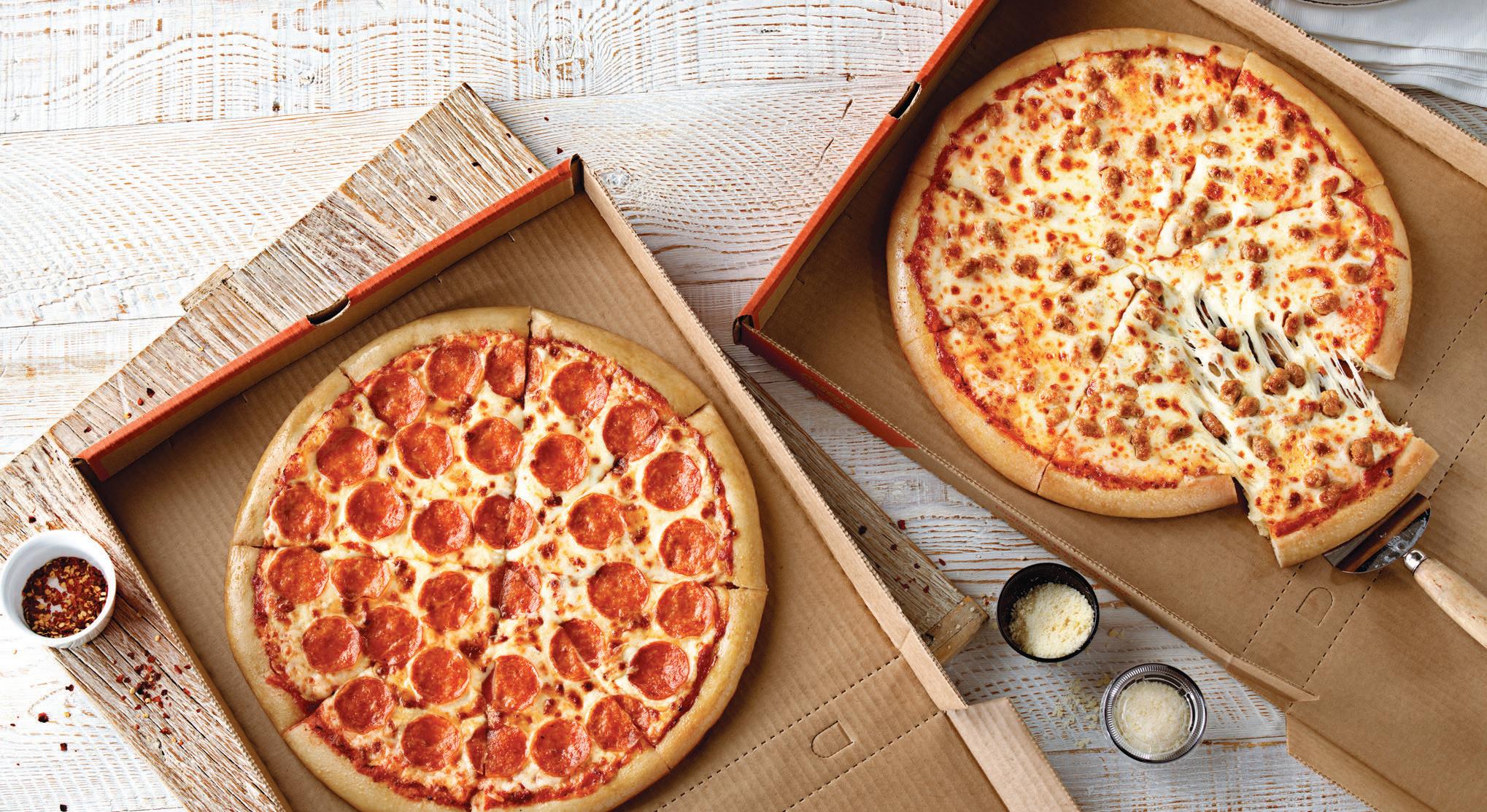

Kwik Trip’s mobile app is called Kwik Rewards, which Servais says customers use religiously to get money off of their gas. “The magic of rewards is cents off gallons,” Servais says. “That’s what drives loyalty in the C-store industry.” q







FOUNDERS: Erik Martinez
HEADQUARTERS: Riverside, California
YEAR STARTED: 2019
ANNUAL SALES: N/A
TOTAL UNITS: 25
FRANCHISED UNITS: Two open/125 signed under development agreements


The growth targets are massive. Cookie Plug, with 23 corporate stores and two franchises open as of early November, wants to have at least 300 locations by the end of 2026 and at least 1,000 units under development. Currently, there’s roughly 130 stores in the pipeline.
“I think we’re well on our way to that, but obviously you have to build the infrastructure and make sure you have the right personnel and teams in place in order to do it,” Wyland says. “That’s what we’re busy doing.”
CHRIS WYLAND WAS IN THE MIDST OF GROWING the franchise base of Roll-Em-Up Taquitos—a chain that signed development deals for 420 stores in six months—when he first learned of fellow Southern California-based brand, Cookie Plug.
Erik Martinez, the company’s founder, connected withy Wyland through Instagram
after having visited Roll-Em-Up several times. He kept up with the press releases and growth targets, and was interested in Wyland doing the same for his emerging dessert company. When Wyland did his due diligence, he discovered a brand that combines urban culture with a variety of cookie flavors. Graffiti covers the walls and hip-hop music plays over speakers—even unedited versions. More than a dozen cookies on the menu invoke the same ethos, like the Snooperdoodle, Mac Daddy, and Nutty O.G. Wyland visited a few locations and fell in love with the vibe. He helped Martinez initiate the process of creating an FDD and began working on everything required for a successful launch, like infrastructure, training, and real estate. The program was officially announced earlier this year.

Martinez’s Cookie Plug journey originated from operating the Cakewalk Cake and Candy Supplies, a cake decorating concept. The business’ success led him to London, where he found international chain Ben’s Cookies. The visit inspired Martinez to launch a cookie brand of his own in the U.S., infused with the culture he grew up in—West Coast 90s hip hop. The first Cookie Plug opened in May 2019 inside one of Martinez’s cake stores. It was only 60 square feet with a counter and enough room for one person to walk inside. The unit opened the day before Mother’s Day and only earned about $150. On Mother’s Day, even fewer cookies were sold. He kept at it, but in the following months, the highest days were just $600–$700.
But then in his hometown of Redlands, California, he came across a 700-squarefoot spot that he was able to grab for $1,300 per month in rent. Martinez started posting about the second location, and Cookie Plug caught fire overnight. He added another store before COVID hit in March 2020, and instead of reeling back, he doubled down. Twenty units opened between 2020 and 2021.
“I mean honestly, all the other brands are boring,” Martinez says. “I mean when you walk into Mrs. Fields, they got a red wall with white writing. You
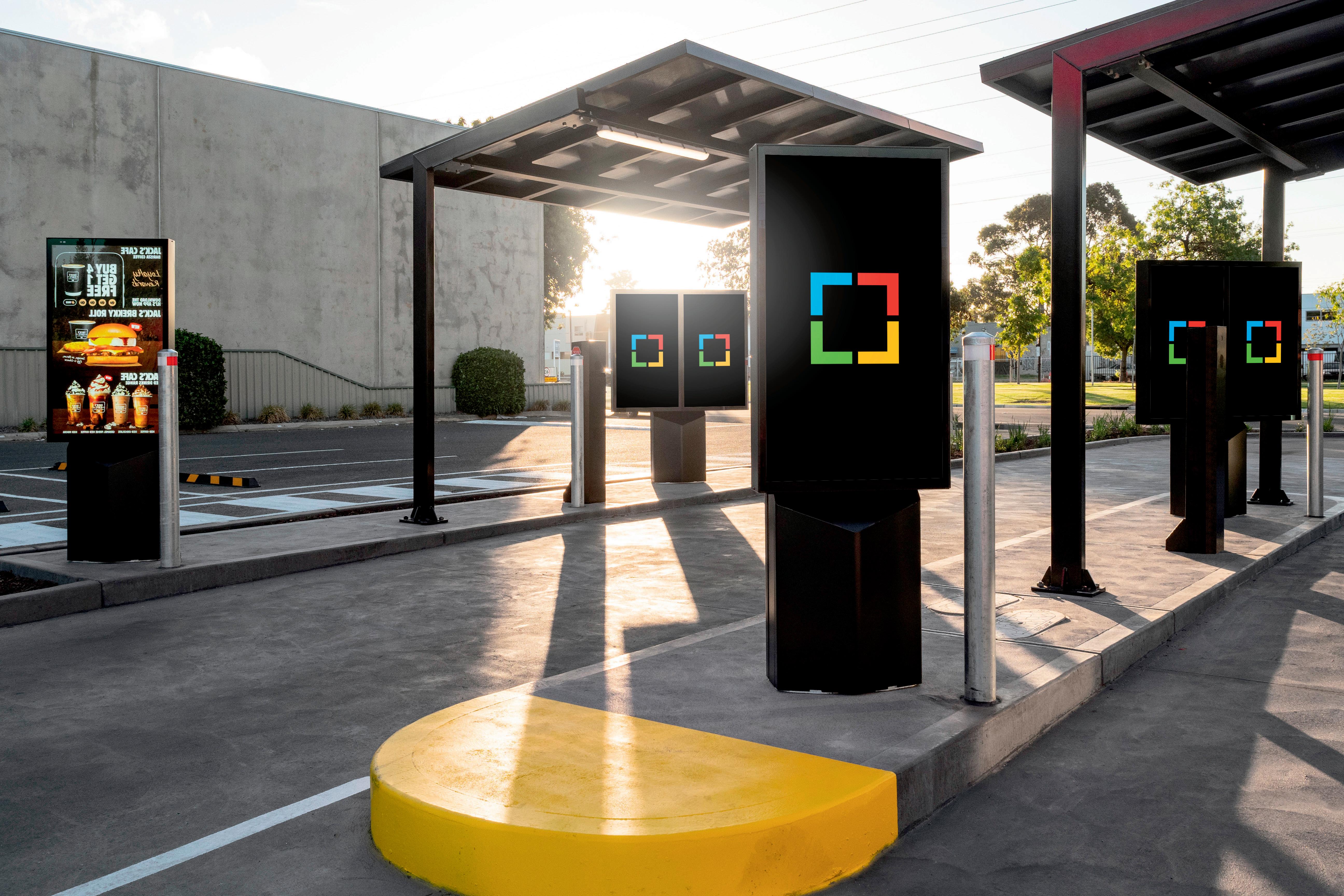

tomize their yogurt with a variety of different toppings like fruit, candy, pretzels, and syrups—started gaining traction in 2005 when Pinkberry opened its first store in West Hollywood, California, which has grown to about 260 franchises in 20 countries. Though Pinkberry touts itself as “the original frozen yogurt that reignited the category,” competitors quickly rose up to vie for a piece of the frozen treat market.
Yogurtland was among the first to offer the self-serve frozen yogurt bar with a variety of flavors available to customers at the pull of a handle. Yogurtland served its first cup of froyo in 2006 in Fullerton, California, and after 15 years has grown to nearly 300 locations across eight countries.
In September, same-store sales were up 27 percent versus 2021, with comp sales up around 30 percent from 2021, according to Yogurtland president Sam Yoon. And 80 percent of stores are outperforming 2019 sales, proving the brand is fully recovered from any pandemic lags, Yoon says.
Trends come and go, but prospective franchisees want to invest their hard-earned dollars in concepts with staying power. Here’s how fro-yo leaders at Yogurtland and 16 Handles are staying relevant.
Frozen yogurt shops are the millennial equivalent to the soda fountains that served as social hubs for teenage Baby Boomers. The frozen treat has gone through multiple popularity booms that seem to fizzle out after a few years, but leaders in the segment are reassuring customers—and potential franchise owners—that froyo is poised for a comeback, and is here to stay.
Though the origins of yogurt can be traced back thousands of years to the Middle East and India, the first commercial frozen yogurt wasn’t available in the U.S. until the early 1970s. “Frogurt,” as it was initially called, was sold only in scoops like ice cream and was more tart than sweet. Soft-serve frozen yogurt was invented in the 1980s, and quickly gained popularity for being the healthier alternative to sugary ice cream since fro-yo contains digestionfriendly probiotics.
The modern version of fro-yo shops—where customers cus-

Yogurtland didn’t reach success by accident. A purposeful, multi-tiered drive to stay relevant has enabled the brand to keep building momentum, Yoon says, plus better-for-you concepts are trending in franchised food and beverage concepts—“contrary to articles in the past that said frozen yogurt is dead,” he says.
While many attribute the explosion of health and wellnessfocused brands to the pandemic spurring people to care more about their health, Yoon predicts better-for-you brands have more room to grow. “This trend will only grow stronger,” he says. “Frozen yogurt is healthier and contains probiotics that boost immune systems. Our frozen yogurt contains at least 10 million cultures at the time of manufacturing, and our flavors are developing around plant-based flavors our guests love, as well as sugar-free options.”
A focus and investment on using high-quality ingredients helps differentiate the brand from competitors in the space. An in-house team of “flavorologists,” as Yoon calls them, ensure customers are receiving the latest global and diverse mix of new flavors at Yogurtland.
The team has a rolling 18-month flavor development plan, and the innovation process—from ideation to 16

Why do the world’s busiest restaurants rely on FIFO Innovations for their dispensing needs? FIFO sauce dispensers are designed around the specific demands of fast-paced restaurants.


Each product helps increase service speed and reduce waste so you can save more! Savewithfifo.com even allows restaurants to calculate how much they can save when upgrading to FIFO sauce dispensers. Explore FIFO’s range of dispensers and discover how they reduce waste, increase speed of service, and help you create consistently amazing experiences.
FIFO Innovations
107-2999 Underhill Ave, Burnaby, British Columbia, Canada, V5A 3C2
PH: 1-800-453-FIFO










PH: +1 778-383-6200













www.fifoinnovations.com





Simple yet durable. Use Sauce Gun Bottle with widely used stainless steel sauce guns for refi llable, time-tested portion control. Large quick-serve restaurants have long used sauce guns for fast, consistent food prep. FIFO’s Sauce Gun Bottle provides an efficient, refi llable alternative to disposable paperboard canisters. Like Portion Pal™, the bottles help restaurants create consistency and cut waste. However, the sturdy construction means you can also dispense condiments that were previously too thick to work with. Now, with just the squeeze of a handle, you can cleanly dispense condiments like Nutella or sour cream.
The always-ready squeeze bottle. Perfect for dispensing ketchup, mayonnaise, mustard, and many more sauces. FIFO Bottle’s bottom dispensing design works with gravity to pull sauce down towards the valve, keeping it primed for fast dispensing. No more banging bottles on the counter! The second opening on top of the bottle provides access for fi lling and in turn ensures proper First In, First Out (FIFO) sauce rotation. As with all FIFO Innovations products, there’s a wide range of accessories available to customize FIFO Bottle™ to your specific needs.
Fast, versatile portion control. With adjustable portion control, 98% sauce yield, and speedy dispensing, Portion Pal™ is the quick-serve industry’s secret weapon. Choose between three sauce dispensing patterns: single hole, ideal for tacos, tortillas, smoothie bowls, or any application needing a single drizzle; or two holes, perfect for wider sauce coverage on subs. Or three holes to provide optimal sauce coverage on buns and sandwiches. Savings from Portion Pal™ can often outweigh the initial investment in under two months! Higher yield means less waste and quick dispensing equals less prep time.






















Fiorucci is proud to offer a full line of pre-sliced Italian deli meat products to quick-service restaurants, for use in a variety of menu applications and chefinspired recipes.
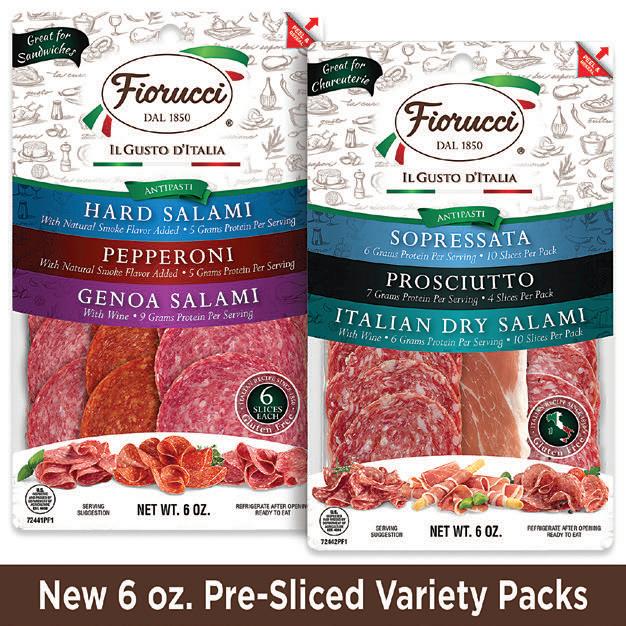

Fiorucci’s Italian Sandwich Variety Pack allows operators to build a delicious, authentic Italian sandwich instantly. Featuring three mouthwatering dry-
goes to waste, maximizing customer usage and output, while reducing backof-house prep. Some favorites include Pepperoni, Mortadella, Hot Capicollo, Salami, Prosciutto, and Prosciutto di Parma.



Our 1 lb. All-Natural Charcuterie Slices, in various flavors—all with no hormones, antibiotics, nitrates, nitrites, preservatives, or artificial flavors, colors, and ingredients—can be applied to charcuterie boards, pizzas, salads, soups, pastas, and much more, while providing perfect portion control, versatility, and minimal prep time for operators.

cured meat combinations that are ready to eat any time, each 6 oz. resealable package contains pre-sliced Hard Salami, Pepperoni, and Genoa Salami, six slices each. Operators could also prepare an impressive charcuterie tray instantly with Fiorucci’s Italian Charcuterie Variety Pack, featuring three premium meats that are ready to eat any time. Each 6 oz. resealable package contains pre-sliced Sopressata, Prosciutto, and Italian Dry Salami.
For larger recipes and added portion control, we offer pack sizes ranging from 1 lb. to 2.5 lbs. pre-sliced deli meats in resealable packages to ensure no product

We are also proud to introduce our new traditional and Hot Sopressata deli meats in 2.5 lbs. pack sizes to for an


Fiorucci is the brand of specialty meats that delivers the true taste of Italy. For over 170 years, we have used old-world recipes to produce a full line of authentic Italian deli meats, using only handtrimmed cuts of premium pork and the finest ingredients, then slowly aging them to perfection. Our portfolio includes a variety of pre-sliced and bulk meats including Prosciutto, Pancetta, Salami, Pepperoni, Sopressata, Jamón Serrano, Capicollo, Mortadella, Chorizo, and other specialties, including our best-selling Paninos line.
elegant, zesty flavor when added to any recipe. All our products are gluten-free, low-carb, low-sugar, and high in protein, with original recipes that have been passed down through three generations for more than 170 years, dating back to 1850 in Norcia, Italy.
For more information on Fiorucci’s various foodservice and retail products, please visit us at www.fioruccifoods.com, Facebook, Instagram, YouTube, TikTok, and Pinterest, or reach out to us at cfa.marketing@campofriofg.com


Frymaster manufacturers a broad portfolio of commercial fryers featuring innovative technologies that simplify frying and oil management. We are constantly engaging with our customers and designing innovative solutions to make frying easier and more profitable.




By understanding the needs of our customers, Frymaster leads the industry in creating innovative solutions that make frying safer, easier, and more profitable.






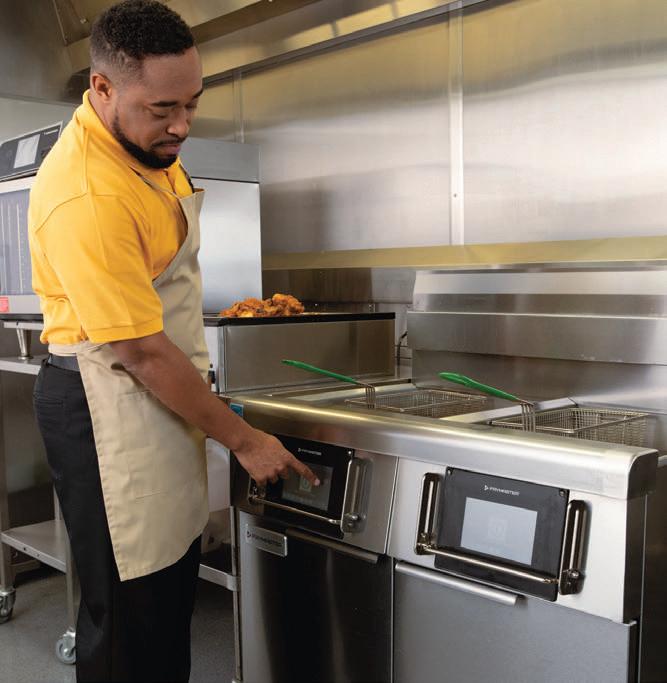
























With simple and easy to use touchscreen controllers, training crews has never been easier. The fryer is now able to alert crews to fi lter during idle periods, provide on screen troubleshooting


from crew members. Simplifying the most tedious fryer maintenance task encourages better oil management and translates to increased profits.





Frymaster has embraced the power of internet-connected fryers to drive continuous improvement in the world of frying. Updating software and menus can now be done remotely across an entire system of fryers. For customers, the ability to see how their fryers are being used in their restaurants remotely from the Cloud improves management capabilities. As we learn from today’s connected fryers, we are developing tomorrow’s innovation.
Frymaster’s award-winning commercial fryers take frying to a new level through innovative solutions to operational issues. We’ve taken the guesswork out of oil management for crews and operators. Our fryers walk

Frymaster
8700 Line Avenue
Shreveport, LA 71106


www.Frymaster.com




information when needed, and even tell the crews exactly when the oil needs to be replaced. Instead of crews having to learn how to operate the fryer, Frymaster fryers instruct the crews on how to properly manage the oil and extend oil life.



Manual methods of fi ltering oil are messy and dangerous. Frymaster has designed fryers in a wide range of sizes that can automatically fi lter the oil. Oil from the most challenging applications, like fresh breaded chicken, can be fi ltered without manual intervention




crews through step-by-step processes to fi lter the oil simply and safely to extend oil life and increase profitability. Everybody wins with Frymaster fryers.

In addition to the company’s core product offering, Sunny Sky can develop custom private label solutions that meet the strategic needs of our customers, creating long-term trust and mutual benefits. We have the unique ability to go from concept to fi nished product in as little as 6 weeks and are renowned for our attention to service and proactive approach to increasing our customers’


SUNNY SKY PRODUCTS is a leading manufacturer of beverage solutions, specializing in liquid and powder concentrates for hot, cold, frozen, and beverage enhancer products. We measure our success by the success of our customers, which is why we pride ourselves on our commitment and dedication to creating, manufacturing, and delivering top quality products and customer service.











Sunny Sky Products produces a wide variety of on-trend, high-appeal, and easy-to-execute solutions offered as core “everyday” products as well as seasonal LTOs. The company’s products include: cappuccinos, hot chocolates, iced and cold brew coffee, creamers, fountain drinks, slushies, bar mixes, smoothies, frappes, energy drinks, juices, teas, sweeteners, flavored syrups, sauces, and toppers.

Sunny Sky Products is a Beverage Solution Provider for the foodservice and convenience store industries offering an extensive portfolio of licensed and in-house brands with the ability to create custom solutions.
Beverage Expertise:
• Hot Beverages

• Cold/Chilled Beverages

• Frozen Beverages
• Beverage Enhancers
• Alternate/Secondary Sourcing







sales. Our marketing team is here to help ensure the success of your beverage program by providing market research, consumer insights, machine graphics, and in-store POS.

Production facilities are fully certified and excel at plant audits, providing manufacturing solutions you can trust. Our extensive product portfolio is distributed domestically and internationally across five continents and over twenty countries.

We continue to expand our capabilities and portfolio to provide value to foodservice through our innovative and on-trend offerings. Our versatile products expand the scope of application in various types of end products that enable you to do more with less while keeping back-of-house operations simplified.
Sunny Sky Products 11747 Windfern Road, Suite 100 Houston, TX 77064







PH: (877 ) 235-6466
www.sunnyskyproducts.com











From revitalizing company culture and introducing a new store design to acquiring Del Taco, Jack in the Box is once again on a winning streak.





Donning a Ted Lasso costume for Halloween last year, Darin Harris just so happens to share a few qualities with the fictional American college football coach turned English soccer coach—from his optimistic demeanor to his ability to win over skeptics. Though, to be fair, Harris had no shortage of restaurant experience when he joined Jack in the Box as CEO.
He helped lead the turnaround of Cicis Pizza as CEO from 2013 to 2018, resulting in 17 consecutive quarters of same-store sales and traffic growth after the brand was bought by a private equity firm. (For context, Cicis faced five straight years of negative restaurant sales and more than 200 restaurant closures before Harris joined). Before, he also revitalized restaurant growth in his senior vice president role at Arby’s, leading the global strategy for international, franchise, and non-traditional development.
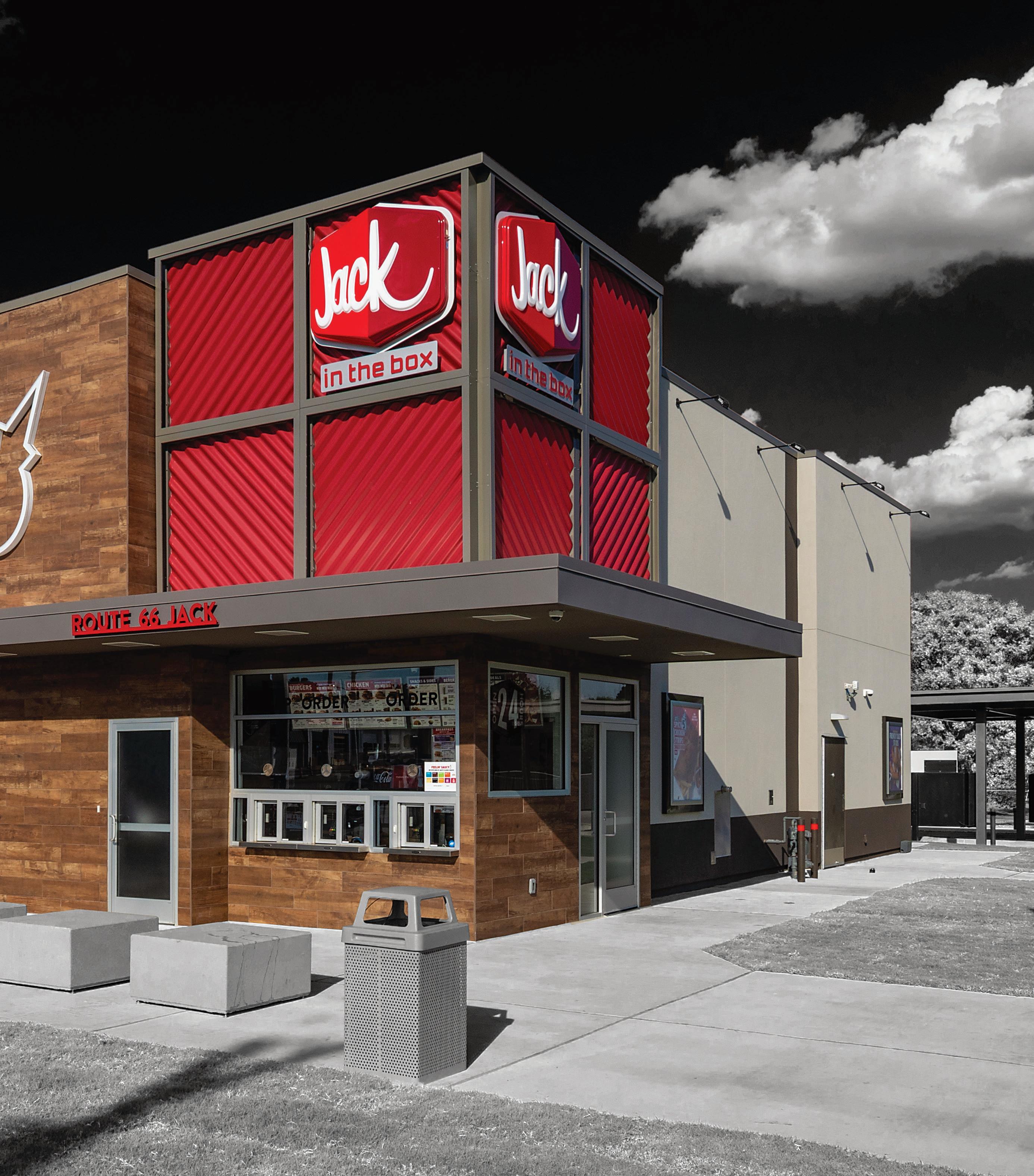
Upon joining Jack in the Box in June 2020, Harris was tasked in his first 90 days with every new CEO’s dream—settling a two-year-old lawsuit with the Jack in the Box National Franchisee Association, which represents 95 franchise owners with about 2,000 of the brand’s more than 2,200 restaurants.
However, his diligent work paid off. Jack’s stock price, as of press time, was hovering around $89, an increase of 170 percent since Harris came on board. Overall franchisee satisfaction scores also improved from 56 percent in 2020 to 72 percent. He attributes Jack’s successful turnaround to clarifying the brand’s strategic direction, re-establishing franchisee relationships, hiring a new leadership team, and focusing on culture.
Delving into the latter, Harris faced another immediate challenge when he entered an empty office during a pandemic and began assembling a new C-suite at a time when people were still nervous about meeting in person.
“Just trying to figure out, how do I roll up my sleeves and understand the business, and understand what really happens at Jack in the Box and the culture and the people and franchisees, was a huge challenge,” Harris says.
The lack of in-person meetings led to missed moments to connect and build culture, “because you’re focused so much on how do we execute, what do we need to get done today,” he adds. “A whole new leadership team didn’t know their employees personally, because they weren’t seeing each other in the office each day.”
Though Harris admits the solution to building a strong culture in today’s environment is ever evolving, building time in the schedule to get to know employees and ask about their families has boosted morale, and even helped the team align on a shared vision and strategy.
“If we get people and culture right, 90 percent of our success will come from those two things,” Harris says, plus “having a clear strategy and being able to adapt.”
If rising sales figures are the measure of success, Harris must be on to something. In 2021, Jack in the Box reported $1.8 million average-unit volumes—up 20 percent from 2020, and providing $4.3 million enterprise average EBITDA, Harris says.
In the fourth quarter ending on October 2, Jack in the Box reported total revenues of $402.8 million—an increase of 44.6 percent from last year during the same period. The brand ended Q4 with 2,181units, including 2,035 franchises and 146 company-run locations.
A significant driver of Jack in the Box’s success over the last year can be attributed to a strategic acquisition completed in March 2022 of Del Taco, which comprised about $126.3 million—nearly 32 percent—of the total revenue in Q3.
Aligning menu offerings, company cultures, and guest profiles drove Jack in the Box’s interest in the $585 million purchase of Del Taco, another California-based American fast-food chain that offers burgers, fries, shakes, and, no surprise—tacos. By acquiring Del Taco, Jack in the Box added about 300 corpo-
rate-owned and 300 franchise-owned units under its portfolio, growing Jack’s overall reach to more than 2,800 locations spanning about 25 states.
There was also the opportunity for Jack in the Box to learn from Del Taco’s success with its “Fresh Flex” prototype, a new restaurant design that dropped in January 2021 and led to increased franchise deals for the 600-unit-plus franchise. Highlights include third-party delivery pickup stations, double drive-thru lanes dedicated to mobile or delivery orders, and a
kitchen redesigned for optimal labor efficiency.
Following the deal, Harris and his team reflected and realized it “had been a very long time” since Jack in the Box released a new prototype, Harris says.
“So our focus became, what can we do to make this a more viable development opportunity for growth?” he says. “One, it has to have a great image to the street, but it also has to be more cost effective and efficient to build and have a great economic model.”
Del Taco’s Fresh Flex design was based off of a previous Jack in the Box prototype that a former architect brought to Del Taco, Harris reveals, which they tweaked and improved upon.
“We very quickly said, OK, this is very interesting,” Harris says. “Why don’t we take their learnings and provide our new image to a building that’s already more value engineered? And that’s what we were able to do.”
In October, Jack in the Box announced its new “CRAVED” model—which stands for “Cultural, Relevant, Authentic, Visible, Easy, and Distinctive”—with a new restaurant opening in Tulsa, Oklahoma, at only 1,350 square feet, less than half the size of Jack’s typical dine-in restaurants. The new prototype features a double Y-lane drive-thru and pickup window, no interior seating to lower building costs, dual assembly kitchens, and exclusive parking for mobile and third-party delivery orders— sound familiar?
The brand also brought a more modern design and color palette to its restaurant of the future with warm wood tiles, natural concrete waiting blocks, graphic poster panels, white cube tiles, and upgraded lighting and landscaping.

“This was only the beginning of how we will continue to evolve both brands through the shared model,” Harris notes.





The goal of the new prototype was to reduce buildout costs by 18 to 23 percent while also increasing real estate flexibility, says Tim Linderman, chief development officer at Jack in the Box. The model is designed for free-standing locations, but can also be adapted to fit in a variety of spaces such as C-stores, travel plazas, and endcap locations. The design is also meant to attract franchisees, both new and existing.














As labor woes impacted the entire restaurant industry, Jack in the Box began trying out an innovative solution in April by hiring a robot at its San Diego location. The burger chain tested Miso Robotics’ fry-cooking robot Flippy 2, which uses AI to identify and pick up food, then cook it in the correct fry basket. Miso estimates the robot increases throughput by 30 percent, or roughly 60 baskets per hour. Jack also piloted Sippy, a POS-integrated robot that automatically dispenses beverages and seals cups.
“With our drive-thru sales skyrocketing amid the pandemic, which accounted for 85 percent or more of a store’s sales, we needed a new prototype that would align with evolving consumer preferences,” Linderman says. Before COVID, drive-thru accounted for about 70 percent of sales. “We believe that offpremises will remain a preferred method of consumption for many of our guests and we want to ensure we are meeting and exceeding their expectations.”
In November, Jack in the Box revealed plans to sell at least 250 company-owned Del Taco restaurants—about half of the system’s footprint—to prospective and current franchisees. The move to refranchise Del Taco will help the burger chain land more securitized debt, financed by royalty fees from owners. To assist in the effort, Jack partnered with The Cypress Group, a restaurant and franchise investment banking firm with more than 30 years of multi-unit M&A and restaurant refranchising experience.




While Jack in the Box’s franchise footprint previously comprised about 93 percent of its system, the combined ownership shifted owner-operated units to about 84 percent. The refranchising plan will aid in Jack in the Box’s goal to get back to its previous ratio of company and franchise locations. An assetlight model should also help shield Jack in the Box from some inflationary-related pressures.

“Inflation is something that’s impacting everyone in the industry right now, so we’ve become more disciplined in our pricing strategy and are investing in the right technology to support that,” Harris says. “Partnering with our supply chain vendors to meet these challenges head on has been key to ensure those relationships remain steady for continuity sake.”
“At the restaurant level, we’re continuing to test and perfect our robotics cooking technology and the flexibility of our location prototypes to stay on the leading edge of innovation in the [quick-service] space,” Harris says. “We are constantly looking for technology opportunities to drive performance. This could be done with expansion of Flippy, or through other pilot programs that ensure the restaurant operations provide a more seamless, quick and efficient experience for the customer.”
Jack hired chief information officer Doug Cook to enhance these efforts by improving AI and removing more costs from the P&L. Cook has more than 20 years of experience in this area, including at Pizza Hut and Sonic.













“Innovation is at the heart of Jack in the Box. We had to reignite that across all aspects of our business: marketing, development, operations,” Harris says.
An upgraded website, a mobile app update, and a new loyalty program—dubbed The Jack Pack, which has more than 2 million members—round out Jack’s recent digital advances.
“We recognized that our current system for our app and website was a barrier that we could improve upon,” adds Ryan Ostrom, chief marketing officer at Jack in the Box. “As such, we partnered with Bounteous to launch a new ordering website and mobile app that integrates with our loyalty program.”




Partnerships are a key area quick-service restaurants are leaning into to drive interest and sales from younger consumers, especially with athletes and other well-known public figures. McDonald’s collaborated with K-pop group BTS for both sig-

nature meals with special dipping sauces and merchandise last year, for example.
In July, Jack in the Box partnered with Star Wars actor Mark Hamill to highlight the launch of French Toast Sticks, returning to the brand’s menu after a 10-year hiatus. The sweet, vanilla-battered product starts at $2 and comes in three or six pieces, or as part of the Jumbo Breakfast Platter.
And unlike other competitors in the space, there isn’t an 11 a.m. deadline for customers to order the breakfast item.
With the majority of stores open 24 hours a day, “we do not follow the rules of breakfast only being confined to the morning,” Ostrom says. “At Jack, you can get tacos for breakfast. You can get breakfast for dinner. You can get food late at night. People crave different flavors at different times, and our brand likes to offer a variety of choices and let people taste outside the box and live outside the box on their terms.”
Jack in the Box also teamed up with reality TV star Kyle Richards in October to launch limited-time-only Monster Tacos during Halloween season—a larger version of Jack in the Box’s tiny tacos, topped off with melty American cheese, shredded lettuce, and taco sauce.


“We knew she was a known, massive fan of the brand, and given her love of Jack tacos and connection to Halloween horror movie culture, it made sense to bring her on board as we popped up with Monster Tacos,” Ostrom says about Richards. “These are the scrappy and authentic partnerships we are looking to continue to execute in the months to come.”
“People are so used to the burger brands or the chicken brands. We are different. At Jack, we are a burger brand that is famous for our tacos. That makes us unique,” Ostrom adds.
The brand also capitalized off of an unintentional, non-official partnership with J-Hope when the BTS star released his new album called “Jack in the Box” in July. “With the record dropping in mere days, we needed to act quickly to catch the news cycle,” Ostrom recalls.
Ostrom and his team did a deep dive into the BTS universe and unearthed a recurring inside joke between J-Hope and his fanbase about the singer’s love for drinking Sprite, and subsequently released a promo code for fans to receive a free Sprite with a purchase timed with the release of the record.
“In less than 48 hours, we came up with, and executed, an authentic way to connect the brand to ‘Jack in the Box,’ the album,” Ostrom says. “All told, the campaign received more than 1 million TikTok views through user-generated content and over 700 million earned media impressions.”
About 70 percent of Jack’s franchise operators started their brand journey working at the restaurant or corporate level, which Harris believes is a testament to their commitment to grow from within, he says.
As additional proof, the rollout of a new training platform in the third quarter of 2022 increased general manager certification from 25 to 80 percent, Harris notes. The new platform also increased performance, which in turn boosted retention.
And “despite the current scale of Jack in the Box, there is still so much opportunity for growth for us in untapped markets across the country,” he says.
Since the relaunch of the brand’s franchise sales program in mid-2021, Jack in the Box, as of press time, had signed 68 agreements for 267 new restaurants. Of that, by Q4, 155 were signed within the past 12 months, a new singleyear record. With discounted royalty incentive programs for multi-unit franchisees and AUVs topping $1.8 million, Jack in the Box is setting itself up for explosive growth. By analyzing demographics and completing a strategic market plan that identifies key areas for new Jack in the Box restaurants, Linderman, CDO, estimates the brand has more than 1,500 opportunities in its current footprint, and 2,250-plus opportunities in new markets. “We believe there is an opportunity for about 6,000 total restaurants in the U.S.,” Linderman says. Growth endeavors are focused on multi-unit investors in markets east of the Mississippi River, he says. Additionally, remodeling current franchisee locations is in the works. Owners have submitted more than 360 reimage forms so far to update their restaurants with the new CRAVED image and design elements, and 256 were cleared to proceed as of press time. Many franchisees are also interested in building the 1,350-square-foot prototype, and while Jack in the Box is allowing a few lucky owners to test the new image, “we’re openly trying to hold them back a little since we’ve got to test it and get consumer feedback,” Harris says. Seeing current owners excited about building more restaurants is a 180-degree turn from the dynamic franchisees had with the franchisor when Harris first joined the brand. “It goes back, whether it’s with the leadership team or franchisees, to rebuilding that relationship,” Harris says. “It’s enabled us to do things like utilizing our franchisees’ knowledge, adapting to headwinds, coming up with the new prototype—they’re involved every step of the way.” q
 Callie Evergreen is a Senior Editor at QSR She can be reached at cevergreen@wtwhmedia.com
Callie Evergreen is a Senior Editor at QSR She can be reached at cevergreen@wtwhmedia.com






When Dave’s Hot Chicken COO and president Jim Bitticks joined the company, he admittedly knew little about the chain’s humble upbringing.

So, like anyone with a cell phone or computer these days, he Youtube’d it. Bitticks found a video from 2017 of two men trying Dave’s Hot Chicken for the first time at the concept’s parking lot pop-up, founded by Arman Oganesyan, Dave Kopushyan, and brothers Tommy and Gary Rubenyan.
“When they bite into the food, I’m not even kidding, one of the guys’ eyes rolled back in his head and he’s like, ‘Oh!’ And there’s all sorts of expletives, and ‘They’re like, oh sh**, that’s so good,’” Bitticks says. “How do we operationalize that? How do we operationalize that ‘rolling in the back of your head’ moment? That’s been the challenge. But I think that’s been our focus. From the very beginning, it’s about the food. Nobody gives a crap about this, that, or the other thing. They care about the food.’”









Dave’s Hot Chicken might just be one of the fastest-growing franchises in restaurant history.
Oganesyan remembers plenty of moments like those, back when customers would wait in the parking lot for two-and-a-half hours. The environment was nothing special; it was just a tent, a couple of fryers, and some tables. The menu, based around the Nashville hot chicken craze, is what drew crowds. As Oganesyan says, “Food is our superpower.” When the fast casual transitioned to its first brick-and-mortar, the founders had an opportunity to visually invoke the same feelings customers have when they first bite into a tender or slider. At the start, it was decided that every store would look different to prove Dave’s authenticity. From there, “the coolness of Dave’s just evolved,” Oganesyan says.
Fueled by a passion for food and sympathy for people who didn’t have access to Nashville hot chicken outside of Southern California, the founders wanted to plant as many flags as possible throughout the U.S. What they had on paper compared to what happened is still difficult for Oganesyan to wrap his mind around.

Thanks to a well-built franchising program, Dave’s finished 2022 with roughly 100 locations—including international spots in Canada and Dubai—after starting 2021 with just seven stores. There are 620 units in development, and 85 restaurants are expected to debut globally in 2023. The company believes there’s room for 1,000–1,200 stores domestically and another 800 to 1,000 internationally.
“To be here now, it’s pretty incredible, but I think we also realize that we still have a lot of work to do. We still have a lot of stores to open,” Oganesyan says. “We have a lot of franchisees. So right now our priority is making sure that our operations and the stores are running really well so franchises continue to want to open up stores. So we understand that we’ve done a lot, and we also understand there’s still a lot to do. We’re still in that work mode—continuously trying to improve the brand as much as we can.”
Bill Phelps, cofounder and previous longtime CEO of Wetzel’s Pretzels, attributes much of the growth to understanding the customer base, which is the 15- to 30-year-old male demographic. That group hasn’t changed much from the early days of the parking lot and the first brick-and-mortar unit in Hollywood. Phelps says no one knows more about capturing that target audience than Oganesyan. The CEO, a former Nestlé marketing man himself, describes Oganesyan as the best marketer he’s ever worked with. That’s because all the video and photographic content on TikTok, Instagram, and other platforms are organic, genuine, and appealing. As the chain’s footprint has remarkably expanded, Yelp and Google scores
have increased in the past couple of years, which tells Phelps that Dave’s is doing what’s necessary to maintain a consistent guest experience.
Last year, the brand caught the eyes of Grammy-award-winning artist Drake, who loved the food so much he took a minority stake in the company, along with Samuel L. Jackson, NFL Hall-ofFamer Michael Strahan, and Red Sox owner Tom Werner.
“When you’re in the first couple of weeks at the parking lot, cooking food and making 100 bucks a day, if somebody told you you’re going to be partners with Drake in a couple of years, you’re probably not going to believe it,” Oganesyan says. “So it’s definitely surreal and it just validates that everything we’ve done have been the right things. Keeping the brand authentic, keeping it about the food, keeping it about the customer experience. All that paid off enough that one of the biggest people in pop culture invested into the brand. So it was surreal. We were big fans of him. We still are. And like I said, it validated everything we did and it’s still kind of surreal and hard to believe.”
Although Dave’s is headquartered in Southern California, it has locations in multiple states thousands of miles away, like Wisconsin, North Carolina, Ohio, and New York. The intention is to be a national brand, and Bitticks—formerly the chief restaurant officer of Blaze Pizza—came with a playbook. After all, the pizza chain was once called the fastest-growing restaurant chain in U.S. history. PFG is the distributor, so a countrywide network has been lined up. In terms of markets, the critical factor isn’t so much the demographics of a particular city, but more so the quality of the franchisees driving expansion. Operators typically sign on for six to 10 stores, depending on experience.
Dave’s is willing to go anywhere if the operator meets expectations. The chain moved into Tutalatin, Oregon, a suburb of Portland, in an endcap location, and the team was shocked by the sales volume. The brand opened on the same day in Denver, Colorado, but in an urban endcap spot, and sales were just as impressive. The same results happen with standalone locations. The standard real estate footprint is between 2,000 and 2,500 square feet. The smallest is 1,400 square feet and some reach 3,000 to 3,500 square feet.
Ten to 15 percent of the system uses drive-thru, and the brand opened a ghost kitchen in 2021. A pickup-only location is in development.
“Clearly, it gives franchisees confidence that they can invest in this brand, because we opened up in Menomonee Falls and I don’t know about you, I’ve never heard of Menomonee Falls before,” Phelps says with a chuckle. “It’s up near Milwaukee, and we opened it up, and it was great. We opened up into Tual-







atin, Oregon. I had never heard of Tutalatin, Oregon, before, and we were knocking it out of the park. And again, both of those cases, we had great franchisees that had restaurant experience in the market and picked great real estate. And that’s been our model and that’s going to continue to be our model.”
To support growth, Dave’s built five training teams that are deployed when restaurants open. The chain has opened as many as four stores in one day thus far.

Bitticks believes the chain could release eight groups at once, if necessary. The teams, who feel like “rock stars when they’re presenting and turning on a store in a particular market,” the COO says, copy the feel and vibe of the original location. If performance is slipping at all, Dave’s will send another team to help, but that’s only happened once. Thanks to the franchise model, the brand can fully pass the baton once the operator
surpasses three to five stores. These franchisees have training squads and open self-sufficiently as they expand.
Bitticks, Oganesyan, and other Dave’s executives double as franchisees to better understand what they go through on a day-to-day basis. It also proves to operators just how much they believe in the model. In addition to explosive franchise growth, the chain plans to open one to two company-owned restaurants per year.
“It goes along with that same concept of having skin in the game,” Bitticks says. “If we only had franchise restaurants, then franchisees feel like we don’t know their pain. We don’t feel their pain. So having a company footprint is important to us, as well as leadership having real skin in the game by being franchisees themselves.”
More eyes will be on Dave’s going forward. In the fall, the company launched its first national advertising campaign called “Don’t Die Before You Try It,” starting with a couple of dark comedy commercials where customers tell stories of their loved one’s untimely fate through crazy events and lament they didn’t have a chance to try Dave’s food.
The campaign showcases the brand’s desire to focus on what got it here. That starts with the food, followed by the profitability of restaurants.
“The growth will take care of itself if we do those two things, and franchisees will clamor to open their second, third, and fourth locations because it is a really profitable model with very high sales,” Phelps says.
“And so those two things together, we keep the sales going by keeping the chicken amazing. And we keep the growth going by keeping the profitability amazing.” q
 Ben Coley is a Senior Editor at QSR He can be reached at bcoley@wtwhmedia.com
Ben Coley is a Senior Editor at QSR He can be reached at bcoley@wtwhmedia.com
Just one of many ways BOHA! digitizes your back-of-house.
Ditch the masking tape, paper, and pencils for a solution operators, franchisees, and BoH staff love. BOHA! automates and simplifies everything from labeling, to temping, compliance and HCAAP reports, checklists, employee training, and more:

• Slash labor costs
• Improve accountability
• Prevent unnecessary food waste
• Enhance Food Safety & Quality
Across ALL locations — from the cloud
www.transact-tech.com/qsr-mag








When the pandemic arrived in March 2020, and consumers stopped dining indoors, a movement in the restaurant industry gained speed that’s led to an expanding number of ghost and virtual kitchens.
Restaurants began to depend on central facilities to fulfill takeout and delivery, and to deliver off-premises demand through lower-cost means. Virtual kitchens served as replacements for indoor dining, enabling entrepreneurs to open at a fraction of the cost of building and developing a stand-alone restaurant.
Why spend half a million dollars to develop a brick-and-mortar outlet when you could launch a ghost or virtual kitchen for about $50,000, or a fifth the price? In addition, restaurateurs can stack seven or eight takeout eateries, as hospitality firm C3 does when it clusters several of its brands—Umami Burger, Sam’s Crispy Chicken, and Krispy Rice—into one virtual kitchen facility, cutting costs and reducing staff.

Headed into 2023, the future of virtual kitchens is becoming more fact than apparition.
Several companies flourished such as Kitchen United and REEF Kitchens, expanding at a crisp pace. But there have been roadblocks. Butler Hospitality, which was created in 2016, raised $50 million in funding, and provided room services to numerous hotels from central kitchens, shuttered in July 2022.
Now that the pandemic has mostly settled and customers are venturing back inside restaurants, how are these enterprises faring? One expert says growth has stabilized, but several of these ghost kitchen organizations have garnered considerable financial investors and keep growing despite the dine-in boom.
Without a doubt, the pandemic fostered the growth of virtual and ghost kitchens, underscores Lee Schulman, president of Atlanta-based Panacea Management Group Consulting, a restaurant advisory firm. “When all of a sudden, people couldn’t dine out, with the expansion of delivery, it allowed independent operators [via ghost kitchens] to reach the people that formally were coming to them but couldn’t or wouldn’t,” he says.
Schulman called it a “feeding frenzy” because growth was so rapid. “Everyone has a phone in their hands. People had access and it was easy to order,” he says.
Since the pandemic ebbed, Schulman says there has been a “reset.”
“Things have shifted because dine-in is back, though delivery is here to stay. People can dine out now, and they want to dine in with their friends and family,” he says.
Many startup restaurateurs “aren’t ready to go brick-andmortar; they don’t have the reputation or financial backing.
But you can get your feet into the water [with ghost kitchens] at minimal cost, and discover ways to see if the consumer demand or desire is there. It offers exposure,” Schulman says.
Yet only a minority evolve from startup ghost kitchen to full-steam retail storefront. Schulman estimates only about 20–30 percent move into stand-alone eateries. But some turn into brick-and-mortar locations such as Citizens at Hudson Yards in New York City, and Burger Dandy in Franklin, Tennessee.
Schulman adds many ghost kitchens don’t carry the extensive menus of in-dining eateries based on their tight kitchen layouts. Hence, they specialize in a “limited number of menu items that allow cross-utilization of ingredients,” he says.
Established brands open ghost kitchens as well. In Schulman’s own Piedmont Park area in Atlanta, Wendy’s opened in a REEF Kitchen trailer ghost kitchen that enables them to get into a neighborhood, at low cost, and extend their reach. “It’s like a micro market,” Schulman says.
Ghost kitchens have carved out a place, but Schulman believes “hospitality is still a touchy/feely business, and restaurants are here to stay. There’s a social aspect to dining out, and many people want to go someplace else, and not have everything delivered to their door.”
Yet Michael Montagano, the Pasadena, California-based CEO of Kitchen United, sees a bifurcation that could exist in tandem. “I don’t think going out to dinner and ordering in are mutually exclusive,” he says. During the pandemic, Montagano says, many people started ordering in at a higher frequency. And it’s turned into a habit. “Now, they’re consuming the cuisine they like wherever and whenever they want it, and that happens to be in the convenience of their home,” he says.
Kitchen United also secured $100 million in investment in July from Google Ventures, Kroger, and Simon Property Group—a raise that will enable it to “continue to expand its footprint, improve its mature tech stack, and making the economics of delivery work for everyone including restaurants and consumers,” Montagano says.
As of press time, Kitchen United expanded from four locations in 2020 to 14 facilities in five states. It derives revenue from a monthly rental fee and a percentage of sales coming from its channels. When it debuted, it gravitated to aligning with established chefs, since they are more likely to succeed than startups, Montagano says. But recently, it expanded with local brands and upstarts such as The Impossible Shop and Pardon My Cheesesteak, and established names such as Grimaldi’s and Hawaiian Bros.
Thinking innovatively, Kitchen United reached a strategic partnership with Kroger that led to its opening inside locations in two supermarkets in Dallas and one in Houston. Montagano notes, “Kroger locations are ideally located for easy pickup or delivery, and it’s a great madeto-order food offering for Kroger to bring to its

and create better food more e ciently, with ( )

DISCOVER MORE! DISPENSING, REINVENTED!



VISIT US AT BOOTH #1035


customers. Their guests can pick up groceries for the week and dinner tonight.” It also aligned with one Ralphs supermarket in Los Angeles.
Sam Nazarian, founder and CEO of C3, started virtual kitchens in 2019 because, “We saw an opportunity to bring added revenue to underutilized restaurant kitchens and real estate space.” He describes his goal as “reimaging the foodservice industry.”
Nazarian’s virtual kitchens yield “added efficiency. Staff are cross-trained to prepare menus from all C3’s brands, and our menus feature shared ingredients between brands.” He says his partners can generate $1 million per kitchen.
The pandemic taught C3 that “ordering is here to stay. We found that when brick-and-mortar restaurants re-opened, delivery orders were only impacted for a short period of a week or so,” Nazarian says. “The pandemic helped make ordering common place.”
Always thinking out of the box, Nazarian sees growth in the future working in partnerships with top digital creators, YouTubers and gamers, such as Matt Stonie with Stonie Bowls, a collection of poke, salad, and rice bowls. He’s also licensing C3’s brands in airports across the country. He projected to have more than 1,000 digital brand locations by end of 2022.
Also in the vanguard was REEF Kitchens, which started out as a Miami-based parking lot company focused on ways to “making parking lots more efficient in their neighborhoods,” says spokesperson Mason Harrison. And that came to include developing ghost kitchens on their land. As far back as 2016, it launched a ghost kitchen in a carpark in London, which then developed into REEF’s operating the kitchen and restaurants of many startup chefs and operators.
Knowing how real-estate costs usually constitute about a third of operating a restaurant, REEF recognized curtailing those fees gave eateries a much higher chance of succeeding, Harrison says.
So DJ Khaled, well-known record executive and producer, could inaugurate 150 branches of Another Wing, which specializes in wings, jerk chicken, and fried snapper, through REEF; all of which were digital ghost kitchens, opened at a cut-rate cost compared to brick-and-mortar units.
REEF operates its restaurants and functions like a franchisee, paying royalty fees. It began with in-house brands and then created its own concepts such as Rebel Wings and American Eclectic Burger.
Despite the fact that the pandemic is subsiding, REEF’s ghost kitchen business continues to have a place in the industry’s trajectory, Harrison says. “Delivery became a need to have, not a nice to have,” he says.
“Ordering in has replaced going to the grocery store and making your own food. It hasn’t replaced dining out or its quality of food and added service,” adds Rishi Nigam, CEO of Atlanta-based Franklin Junction.
The dust seems to have settled on the shiny new toy of the restaurant industry: the ghost kitchen. Benefits to this model were initially touted as lower real estate and operational costs versus traditional restaurants, zero front of the house costs, flexibility of menu, brand, and pricing, and an opportunity to attract a new clientele via third-party delivery apps. And at the outset, those seemed to be very compelling reasons to “startup” a ghost kitchen.
Many startups across varying industries, eager to disrupt, often make a lot of mistakes out of the gate. The restaurant space is no different, however, here, the main blunder made by some of these startups was not understanding the business of hospitality from the get-go. Ask any successful restaurant veteran what the secret of success is for any profitable and long-standing brand, and they’ll all say the same thing—consistency, and a focus on the customer. By focusing too much on operational ease and efficiency, many ghost kitchen startups failed to convert orders into repeat business, misspent capital, underestimated the needs of diners, and cast a dark shadow over partners that dared to risk their brand reputation to unproven operators.
I spoke to CEO and cofounder of OOMI Digital Kitchen, Markus Pineyro, about what he’s doing differently with his new ghost kitchen business to ensure success into the future and avoid some of the costly mistakes of his tech predecessors. Pineyro is an example of one operator who has sat back, watched the model launch, and took copious notes. He attributes his patience and good timing to what he believes will be the winning ghost kitchen strategy.
“I’m a firm believer that there is success to be found in sitting back, watching and analyzing what works and what doesn’t before proceeding with anything new in hospitality,” Pineyro says.
This kind of patience shown by next-wave ghost kitchen operators just may turn out to be the key reason that they become successful versus the initial rush of waders into the pool. Brands like OOMI Digital Kitchen are banking on their wait- and-watch approach and believe this patience will be the virtue in virtual.
OOMI Digital Kitchen is a digital food hall that launched October in Dallas. It offers items from a roster of well-established brick-and-mortar brands along with craveable items from their chef crafted virtual concepts. With a menu created expressly for takeout and delivery, all OOMI’s brands purport to focus on providing both the culinary excitement
CONTINUED ON PAGE 48
Franklin Junction calls its product “host kitchens”—versus ghost—which work with existing brands, restaurants or hotels, and helps them create a secondary brand for delivery only, adding incremental revenue. They already have
Successful ghost kitchen models are learning from the successes, and pitfalls, of predecessors.
and the food quality consumers expect from an on-premises dining experience.
By examining the approach of the tech-focused entrants into ghost and virtual, OOMI carefully avoided some pitfalls to the underlying initial strategy for ghost kitchen and virtual brands. The lower real estate costs can be a benefit, but also a weakness that generates the need to increase marketing spend that will drive brand awareness. Rather than pay into the marketing rabbit hole, Pineyro and his cofounders instead decided to build their Digital Kitchen in a high-density, urban-residential area in the middle of the hustle and bustle of downtown Dallas.



“We believe the optimal place to build and locate a ghost kitchen is smack dab in the middle of where our target demographic resides—and in an area that is familiar and easily located by both our on-demand workforce of delivery drivers and our customers. With cheaper out-of-the-way buildings, drivers often have a hard time
success is that they haven’t yet focused on the customer or on creating a consistent quality food experience. Pineyro believes that his approach considers all the facets of the nuanced hospitality business that need be addressed to be successful for the next incarnation of ghost kitchens.
Pineyro open-sourced his strategy playbook so that other operators can benefit from this wait-and-watch approach to building a successful off-premises business.
1. Leverage as Much Data as Possible: Hire outside support to uncover customer habits within your delivery radius that zero in on the foods your potential customers want to buy and when. Use travel pattern data, urban planning data, geo fencing cell data, gap analysis, and even SEO search analysis to uncover insights into what sells.
2. Partner with or License Compelling Brands: Don’t just partner or license any given brand; choose brands that have built in customer awareness and affinity and create virtual brands that compliment them. Better yet, find brands that have a cult following and an avid influencer base that will magnify your marketing reach organically.
3. Eyes Drive Buys: Reducing costs by procuring hidden real estate is a mistake; find a location that is convenient for both your customers and your drivers to locate, engage with, and keep top of mind. This will optimize both your delivery and your carry-out business, as both are equally important.
4. Centralize Production: Business models that rely on a patchwork of labor resources in a disparate set of kitchens will see this result in inconsistent product. Keep production in one location to capitalize on product consistency and food quality.
5. Oversee Your Own Operations: Don’t trust unproven entities with your brand, your recipes, your reputation. Having a dedicated operations manager onsite where your product is being made is key to quality and cost control.
6. Vary Revenue Streams: In addition to just a basic delivery model, set up catering partnerships with workforce food program companies, offer brands and menus that will generate revenue during varying dayparts and have a robust offering of marketplace products that can be added on for delivery.
locating ghost kitchens; this frustrates and alienates them as they want to pick up and deliver food as quickly as possible to optimize their tips. We’re also focused on providing customers with the shortest delivery times possible to enhance the quality of our product and the entire customer experience, something our V1 ghost kitchen predecessors grossly overlooked,” Pineyro says.
When the preparation facility is located far from a delivery customers address, there’s a cost to both alienating the people responsible for delivering your food and to providing a poor customer experience from long wait times and/or delivering cold or soggy food.
OOMI Founders never really believed the “zero front of the house costs” proposition touted by early ghost kitchen entrants either.
“Zero front of the house costs are never really zero, they’re just re-allocated into other unforeseen expenses; expeditors, order packers, and even greeters who direct delivery drivers all need to be hired to produce and deliver a quality product for delivery. There seems to always be a cost, both direct and indirect, to each decision you make when deviating from the traditional restaurant model,” Pineyro says.
Veteran hospitality operators like Pineyro know that beyond just location and service, to be successful in any restaurant business, there needs to be a focus on the menu and the food product. The menu needs to be both operationally optimized for efficiency as well as appealing to the customer. One of the main reasons that many of the current ghost kitchens that offer virtual brands aren’t finding
7. Cross-Utilize but Don’t Cannibalize: When matching licensed or virtual brands to your ghost kitchen try to overlap and use each inventory SKU across brands and menu items to limit cost and waste and to optimize inventory throughput. At the same time, still be creative enough to utilize unique SKUs to form interesting builds that vary from menu- to-menu and item-to-item to retain consumer interest and excitement.
8. Provide the Consumer with a Holistic Experience: Focus on each step along the food procurement journey to provide a thorough and thoughtful convenience solution for your customers. Make discovery, sales, order, pick up/delivery, eating, and feedback processes simple, intuitive, efficient, and experiential. Focus on both the food product and the hospitality experience, end to end.
9. Conduct Ongoing and Consistent Quality Control: At each point on the product to consumer journey regularly check for points of failure and opportunities to improve. Preparation, order accuracy, production, make line processes, packing, pickup, and delivery stage gates should each be evaluated and monitored frequently.
10. Invest in Pickup Technology: Food integrity is a key element to food quality. Pick up tech helps to keep food safe, held at the proper temperature, and makes it convenient to access for the delivery drivers who are stewards of your product. Invest in great packaging and locker pods. q
Liz Moskow is an F&B industry expert with a Culinary Institute of America pedigree and over two decades of brand, culinary, hospitality and CPG experience. Moskow is considered a global leader, trend spotter, and trend setter in the food industry. She is based in Denver and is Principal of Bread & Circus Ltd, a consultancy focused on the future of food.employee retention.
“I think the Great Resignation, COVID, social unrest, and gender inequality have given the opportunity for employees to have a voice,” says Kim Rubenstein, cofounder and chief research and product officer of Compatibility LLC, a company that aggregates data to match business mentors and partners for mutual success. “While companies really looked at employees to be loyal, I think now companies are being forced to become more human-centric and really explore their loyalty. And making what’s important to the employees important to them and figuring out there’s a lot of dynamics. There’s a lot that we missed.”
It’s no secret that in the wake of the Great Resignation and the pandemic, the quick-service sector underwent growing pains. And, one could argue, contractions. This is not simply a matter of basic employee dissatisfaction and fatigue, nor is it just dollars and cents. Issues of diversity, equity, and inclusion have become key components in this current paradigm, especially when it comes to employee retention.
The National Restaurant Association’s State of the Industry report for 2022 found 78 percent of operators felt they did not have enough employees to support customer demand, with 70 percent noting they lacked mission-critical staff. And with increasingly high employee turnover rates, recruiting and retaining employees would be their top challenge.

A report issued last January, entitled DEI Initiatives for Miniat Companies, shined a further light. Incorporating data from different sources, the report made the case DEI is not just good for organizational health, but that it impacts a company’s bottom line. Companies that focus on DEI see improvements in work engagement, higher market valuation, increased profits, and yes,
As Rubenstein points out, some people look back at the seemingly “good old days” of employee and company unity before the pandemic. “I think they are fantasies of when we experienced where we were connected with people we felt were in our jam, doing our thing,” she says. “It may have been great individually. I don’t know that collectively we’ve ever really seen it. Do I think economic times have been good and people have been employed? Yes. Did they have jobs or careers? When you look back, some people want jobs, some people want careers, and it really depends upon the lens of the person being asked.”
The tide is turning. Traditional Western corporate hierarchy previously tended to favor white male dominance and a one-size-fitsall model, but people are more diverse and have different strengths and needs. Racial, gender, and cultural diversity is a more critical issue now. The restaurant arena is also different than some other types of companies that have a private corporate environment—it has a very public face involving daily customer interaction.
“I think the definition of value is shifting dramatically,” says Compatibility CEO John Kutac. “As we see the inability to hire, regardless of price point and retain, we’re seeing a lot of private investment go into [quick service] and into glomming up a large number of what might have been franchise owned, or even company owned that might be struggling. But those basic value principles are not necessarily compensation driven. They’re driven by a lot of other factors, and I think most companies need to make that breakthrough.”
Kutac was happy to see the commitment of











































A growing app looks to empower restaurants on a topic vital to the environment, and to guests.
value, and place it in a surprise bag for a third of that value. “Say you put $15 in surplus food in the bag,” Simmons says. “The user buys it for $4.99 through our app; the business gets money; the user gets a good deal; the world saves the C02 emissions from that food not being thrown away.”
Too Good to Go also has an internal system that brands have access to, which manages inventory quantity. Partners can change the number of surprise bags available to be sold depending on how much surplus food there is each day. Every quarter, brands get a payment from the surprise bags they have sold to consumers on the app.

About 40 percent of edible food in the U.S. is wasted. It’s a figure Too Good to Go, a mobile app that redirects uneaten food from retailers to customers, is on a mission to remedy. The company was founded in Denmark in 2016 and has since expanded to 17 countries. In 2020, the brand came to the U.S., establishing a presence in 13 major cities.
“We’ve seen 3.1 million downloads in just two years, which for a consumer marketplace app is pretty substantial,” says Tyler Simmons, head of key accounts in the U.S.
How it works is restaurants and food stores join the app and post “surprise bags” that are made up of food that would otherwise be thrown away. Then, app users can log on and purchase those surprise bags for a third of the normal price.
The app taps independent restaurants and chains of different sizes to get excess food into the hands of consumers. One of the lead selling points is the ease of which businesses can implement the platform; Simmons says the process does not change much from a single restaurant to a larger group. Businesses partnering with Too Good to Go first identify what food is surplus, check its retail
Philz Coffee first partnered with Too Good to Go last winter, says Andi Trindle Mersch, the brand’s VP of coffee operations and sustainability. The coffee chain launched a pilot program with a few stores, then moved to a full-scale launch by March. “For me, that was super-fast,” Trindle Mersch says. “Having been here plugging away on the sustainability part of my role at Philz for years now, the work is very well supported in what we do, but it also is hard to execute; especially when we’ve got retail operations spread across the country, things just take a long time.” Too Good to Go was an easier step to take.
The partnership was facilitated by the brand’s first retail sustainability committee. Trindle Mersch was able to present the opportunity to committee members, who were excited about implementing the concept in its stores.
Thus far, Philz has filled surprise bags with bakery items, but Trindle Mersch says she is looking forward to adding hot breakfast items. She says one added value to partnering with Too Good to Go is the extra data Philz is able to include in its food waste reports.
These internal food waste reports are produced every two weeks and include guidance for stores on what to order based on sales trends, Trindle Mersch says. With the new data from Too Good to Go, the number of surprise bags being sold at every store is also monitored. If one store is selling too many, it’s a signal that it may be ordering too much food, she says. Ordering too little food, on the other hand, leaves room for a negative customer experience. “You have to balance out that optimal customer experience with waste,” Trindle Mersch says.



walk into some of our other competitors, they got a pink wall with black writing, right? Like ain’t nothing cool about any of them. That’s probably where the term cookie cutter came from. No one’s ever done a cookie concept like we have.”
Wyland was named CEO, and Spencer Sabatasso, with past executive stops at Fatburger, Sweetwater Prime Seafood, Baja Sharkeez, and consulting firm Fransmart, joined as vice president of franchise development. Cookie Plug transitioned quite easily into franchising, Wyland says. Not only because of its unique product, but also streamlined operations. Each location averages 800 square feet, and equipment packages are inexpensive; stores use ventless convection ovens and most don’t need a grease trap. Dough is copacked offsite so employees aren’t baking completely from scratch inside the shops. Cookie Plug can open with one employee, and that person can run the whole store until the afternoon shift, which only needs two workers. For evening times on a Friday or Saturday, three may be needed. With all that taken care of, Wyland just needed to focus on standardizing decor and ensuring each shop featured the same layout. Initial costs to open a store are roughly $100,000, and labor expenses run about 16 percent, translating to better margins for franchisees.
In November, there were two franchise locations in Henderson and Las Vegas, Nevada, which both opened to about 300 people in line. Wyland says the plan is to open one store per week throughout 2023. There are core markets Cookie Plug wants to target, but Wyland feels the brand can work anywhere, even with the hip hop and graffiti. That includes suburbia.
The cookie segment saw a flurry of action in 2022. Crumbl Cookies surpassed 500 locations in its fifth year of business, and filed lawsuits against smaller concepts Crave and Dirty Dough over similar branding and packaging. Then there’s Chip City Cookies, which received a $10 million investment from Danny Meyer’s growth fund, Enlightened Hospitality Investments.
Wyland refers to it as the dawn of the cookie wars. However, he doesn’t think anyone will ever look at Cookie Plug and mistake it for another brand. q
OPERATIONS / CONTINUED FROM PAGE 42
larger corporations like Chipotle to becoming pioneers by “integrating DEI a part of their systematic policies and procedures internally,” he says. “They offer Employee Resource Groups, mentorship, and other programming to ensure a culture of an integrated community where employees feel equal opportunities for upward mobility, while fostering a sense of belonging. They are also incorporating DEI as a part of their brand, able to meet the diverse preferences of their consumers, and offering training to franchise owners, [and ] this all translates down to the consumer-facing community. From executive compensation to employee engagement and customer experience, they are industry leaders.” He adds some smaller quick-serves are doing a great job by focusing on driving more female ownership. They are also building stronger partnerships with suppliers and ensuring they share similar values and best practices toward recognizing DEI.
“The [quick-service] world faces a very different challenge than full service dining establishments,” Kutac elaborates. “The low price points that the consumer has been used to for decades has led to operating level decisions that has resulted in a lot of what we are talking about. The need for change—and quite frankly the consumer needs to adjust as well. So that comes from leadership, that comes to equity of pay. Here’s what I always like to ask people: What are we as a society willing to pay? Do we really expect a 99-cent burger still? We shouldn’t. Not from the treatment of animals, not from the methane emission leading to carbon change, not to the treatment of the employee. There’s a massive way to make this change, and we as consumers can make that decision with our wallets.” Having a consistent workforce that is more invested in their jobs because they feel invested in as important. “When you look at all the statistics on retention and why people leave, people don’t say ‘because I couldn’t do my job,” Rubenstein adds. “The resume got them in the door, but it’s not like they left. People leave people, they don’t leave jobs. For the most part, it’s that basic human need that we all have to feel seen, valued, and heard, and it’s more important than a company might realize.”
“Too Good to Go, I would say, really gave us a very tangible, almost dramatic first step, that is actually easy to track and report, and got the whole company around the zero waste goal,” Trindle Mersch says. “It’s just really accessible for everybody across the company, both home office folks and retail folks—it’s really clear what we’re doing.” DIG, an east coast chain with 30 units, is also working with Too Good to Go to limit its food waste. Cameron Bersh, manager of offsite strategy and operations for the company, was already a fan of the app before the brand partnered with it. “I’ve actually always been a very passionate Too Good to Go customer,” she says.
Like Philz, the brand decided to test the waters first and complete a pilot in two of its New York City locations. Bersh says the brand really enjoyed the test run, citing the ease of implementation, and positive customer and operator feedback. This past fall, DIG decided to launch Too Good to Go with its entire system. Typically, each DIG location has a target of five surprise bags per day. “They know they are supposed to make those five surprise bags every day,” Bersh says. “They don’t have to actually check the portal or anything unless they are conscious of the fact that their waste is going to be either up or down. It’s quite seamless from the logistics perspective.”
DIG has been able to work with its operators by looking at internal reporting to gauge how many surprise bags they should be selling, Bersh says. It has been a way for them to engage with the platform. “I feel like the element of the product where the operator is able to add additional surprise bags has really generated a lot of buy-in from them—for them to be more conscious on a daily perspective of how much waste they are generating,” she says. “That ability to toggle upwards and downwards has been really awesome to see a lot of operators actively engaging with.”
Looking toward the future, Too Good to Go wants to expand its presence in the U.S. “Our goal is to be everywhere,” Simmons says. “Our aim is to be that channel for consumers to take action against climate change and against food waste themselves, by just buying a bag of food that’s delicious and well-priced.”
THE ISSUE: Safe fryer oil disposal.


THE SOLUTION: The Shortening Shuttles® allow you to safely and easily pump out the hot oil into the dumpster.

THE ISSUE: Limited space for necessary equipment.
THE SOLUTION: Small footprint of Shortening Shuttles®

Generous capacity ranging from 5.5 to 12.5 gallons.
THE ISSUE : Quality. There is so much junk out there folks are reluctant to buy ‘more junk.’
THE SOLUTION: 30+ experienced industry provider of PROVEN quality equipment.
FRANCHISE FORWARD / CONTINUED FROM PAGE 18
formulation, testing, refinement, and rollout—takes about nine months. A flavor recipe will often undergo about 25 renditions before being released to the market, Yoon says.
Planning back-up solutions ahead of time for any supply chain challenges, plus developing strong relationships with vendor partners, allows the brand to continue meeting the expectations of their guests.
Strategic partnerships are key for any brand trying to stay relevant. Yogurtland, for example, spiced things up in 2019 when it teamed up with Cheetos Flamin’ Hot to offer a new topping for a “sweet and spicy combination,” which paired with a special kickoff event at a California mall where fans could meet Chester Cheetah. Yogurtland also collaborated with Sour Patch Kids in August to launch a limited-time Watermelon Sorbet frozen yogurt, marketed as “the perfect back-to-school treat.”
The purpose? “Creating that buzz and excitement, and bringing fans of those brands and exciting our customers to come into our stores,” Yoon says. “At the same time, it’s an opportunity for our flavorologists to use this occasion to craft amazing, creative, new frozen yogurt flavors.”
While Yogurtland creates its own vegan flavors using an oat milk base, such as Plant-Based Brown Sugar Vanilla, New York-based fro-yo shop 16 Handles has an exclusive partnership with big-name oatmilk brand, Oatly—which means non-dairy flavors like Marshmallow and S’mores flavors in the summer and pumpkin spice in the fall.
16 Handles—named for having 16 rotating soft-serve flavors—was founded in 2008 by Solomon Choi in Manhattan’s East Village, and has since grown to 30 stores across five states. The company claims to be the first self-serve frozen yogurt shop in New York City, and sets itself apart with a modern store design, exclusive product lineups, and integrating mobile app-based loyalty and ordering technology.
16 Handles was recently acquired by its largest franchisee, Neil Hershman, and investor Danny Duncan, who boasts nearly 7 million YouTube subscribers. At 27 years old, Hershman is now CEO of 16 Handles and has built an $8 million dessert portfolio, including seven 16 Handles and other treat franchise stores such as Dippin’ Dots/ Doc Popcorn and Captain Cookie & The
Milkman.
Hershman and Duncan plan to grow 16 Handles beyond the Tri-State market via franchising—despite talk of the concept being a dying fad. “I think those articles are really funny. If it’s just a trend, why have we been writing about it for 20 years?” Hershman says.
“At some point it gets a lot of media and people think it’s really popular, and then stops getting so much media because of the media cycle, but stores stay as is,” he adds. “A lot of stores at 16 Handles comp up every year. People say fro-yo is dying, but yet we have more customers coming in and more loyal customers returning. It’s just not true.”
Since Gen Z is a target demographic for 16 Handles, the ownership duo will leverage Duncan’s audience—70 percent of which ranges between ages 18 and 34—to generate more buzz. “He’s been a big help in figuring out how to target that audience, because if you win it, they’ll come in with their families as well. It’s a great sell,” Hershman says.
On the franchise sales side, Hershman is targeting multi-unit operators by selling discounted packs of three stores, and noted the brand is focusing on markets in Florida and Texas next. The self-serve model saves money on labor costs, and rising average unit volumes with a 550-1,200 square footprint helps attract new owners.
Plus, improved technology lessens the burden on franchisees finding real estate. Historically, fro-yo shops used to be less desirable since they required water lines, high-voltage electricity, and other customization for the frozen yogurt machines. “Tech has caught up, and having directdrive machines is going to be much more efficient,” he says, so franchisees can build in any space.
So while many trends tend to be cyclical, the healthier ice cream alternative looks like it’s here to stay—at least, from Yoon’s and Hershman’s perspective.
“Millennials love the brand in New York, so we’ll keep playing to that,” Hershman adds. “For them, they grew up with frozen yogurt always being available, so to have a cool, clean kind of modern, sleek store to go to that sells frozen yogurt, versus kind of a dingy local shop, is a nice benefit.” q
their existing kitchen, don’t need to invest any new capital, and Franklin Junction serves as the licensee, owning the sales, the listing, driving the promotions, and doing the accounting. The company provides “the tools for existing restaurants to optimize their infrastructure to capture incremental digital business, primarily takeout and delivery,” Nigam says. Franklin Junction operates more than 1,000 restaurants domestically and over 500 internationally.
It focuses more on established brands, such as Hooters, Nathan’s and Arthur Treacher’s Fish & Chips. “That ensures greater likelihood of consumer-demand,” Nigam says. It has partnered with early stage restaurants on select occasions as well.
Frisch’s Big Boy was one of Franklin Junction’s earliest partners. The host kitchens helped it forge into new areas and broaden exposure. In regard to how the post-pandemic rise of dining affected revenue, Nigam says, “There’s a lot happening in the industry now including relaxing of pandemic restrictions and inflation, but we see the convenience of digital ordering, delivery and pick-up to be long-term shifts.”
But it’s not only larger companies opening ghost kitchens. Take Cowboy Chicken, a fast casual of 18 locations ( seven of which are company-owned ), specializing in woodfired rotisserie chicken. In November 2020, when the pandemic was still at its apex, it debuted a spin-off, Smackbird, as a ghost kitchen, to generate a new revenue stream. It’s now available at four Cowboy Chickens. “We could utilize extra kitchen capacity and capitalize on growing interest in the Nashville hot-chicken style menu,” says Sean Kennedy, president of Cowboy Chicken. It devised a different menu consisting of $10 chicken sandwiches, chicken tender meals, family packs, and side dishes such as mac n’ cheese “to appeal to a younger, more adventurous demographic than Cowboy Chicken,” he adds. Kennedy acknowledges as the pandemic lightened, revenue dipped. “But we are confident that we can continue to grow sales in digital channels,” he says. To optimize sales, the brand is extending visibility on third-party platforms, continuing a strong social media campaign, and working with Yelp and Google to build awareness.” q




What was your first job?
My first job was at Billy’s Deli Sandwich Shop in Stone Harbor, New Jersey. I was underage, so needed working papers.
What’s your favorite menu item at D’Angelo Grilled Sandwiches?
Grilled BBQ Chicken & Cheddar with Bacon
What’s on the menu? Each of our restaurants serve up a variety of unique grilled favorites (Korean BBQ, Cheeseburger, Vermonter, signature Steak Number 9) and hot sandwiches (Thanksgiving Toasted, Meatball & Cheese, Pastrami & Swiss), as well as various cold deli sandwiches.
What’s your favorite cuisine aside from sandwiches? I love Italian food for the vast repertoire of recipes. People think Italian food is Pizza and Pasta, but it’s so much more. Italian cooking for me is hard to beat.
Who inspires you as a leader? The people around me. My team inspires me every day! And it’s full of amazingly talented and hard working professionals. I could not be more proud of them!
What’s the best piece of advice that other restaurant executives should hear? Listen to your team members. Being an empathetic leader can boost engagement, increase trust and build better team relationships.
What are some of your interests outside of work? Family, lake time, golfing, skiing
For more than 50 years, D’Angelo Grilled Sandwiches has remained a dining institution throughout New England, serving its crave-able, indulgent, grilled favorites to our loving, nostalgic fans.

D’Angelo Grilled Sandwiches was founded in 1967 as a small shop in Dedham, Massachusetts, about 20 miles southwest of Boston. Throughout the years, we’ve faced a variety of ownership changes and expansion. We were once acquired by Pepsi-Cola in 1993 and are now owned by Wynnchurch Capital, a private-equity firm based in Rosemont, Illinois, which has over $5 billion in assets. Despite our ownership changes, one factor has stayed consistent about D’Angelo Grilled Sandwiches—we have always provided our guests with the freshest, highest quality ingredients and best-tasting sandwiches around while partnering with the communities we serve. Today, with 85 locations already open and operating across five states, D’Angelo Grilled Sandwiches is actively looking to reach new communities across New
England with as many as 20 new company- and franchisee-owned restaurant openings by 2026.
In addition to our storied history, loyal following and all-star executive team, the expansion will be driven by a new restaurant prototype, designed to accentuate the increasing demand for walk-in and carry out service. Future D’Angelo locations will be mostly freestanding or end-cap units ranging from 1,500 to 2,000 square feet. The layouts will also integrate a refreshed interior design including a white brick logo wall/ design package, sleek new menuboards and possible technology advancement, as well as exterior upgrades like a modern paint palette, outdoor signage, and drive-thru services where possible. Opportunities for non-traditional development in airports, C-stores, and other venues are also available. For 55 years and counting, New England residents have continued to show their loyalty to D’Angelo Grilled Sandwiches, making it an ideal region for us to focus our expansion efforts. We’re looking ahead with great enthusiasm. q
Old wisdom has noted that the restaurant industry was slow to adapt to certain technologies. The digitization of, well, everything was a slow and steady process playing out during the 2000s and 2010s. New equipment, technology, and digital solutions were rolled out fast and furious, all with the aim of helping restaurants become more efficient.

Today’s convenience-driven culture is propelling significant revenue for interactive kiosks. It is an industry expected to nearly double to $45 billion worldwide by 2028, according to Statista.
Customers are embracing self-service technology and the benefits of a faster, easier journey. Two out of every three of them prefer having a frictionless, self-service dining option. It’s easier and, in an era of an ongoing pandemic, it’s safer.
Not only that, there is real, measurable business value in kiosks and self-service: Restaurants witness a 30 percent increase in average check size when creating a frictionless order option. It’s why restaurants Acrelec works with—from McDonald’s to KFC to Dunkin’ and Burger King—choose to accelerate their business through selfservice technologies.

Acrelec’s deep knowledge of the quick-service and fast-casual industry has allowed it to evolve its expertise to the next level and provide leading-edge kiosk solutions. The company’s fully customizable technological advances, wide range of kiosks, and global support infrastructure make the difference and are why global brands have given Acrelec their trust.
Specifically, here are three ways restaurants can up their game with self-service ordering and help drive growth.
With Acrelec’s cloud-based deployment tool, restaurants can deploy apps for integration with all major POS providers. They enable hardware and software for both Acrelec and third-party applications and effortlessly manage device fleets remotely with the power of a cloud-based deployment tool called the ACRELEC Transformation Platform (atp). Acrelec monitors hardware,
peripherals, and software operations so restaurants receive alerts even before they realize there’s an issue.
Creating a personalized brand-specific digital ordering solution is a great way to build customer loyalty, increase average check size, and reduce order time. Acrelec’s Product Recommendation Engine harnesses AI to drive growth and better performance with personalized product recommendations. The flexible digital ordering engine enables AB-tested content strategies and UI analytics.
Acrelec uses wireless Bluetooth technology to help restaurant crews easily locate and serve customers when their orders are ready. It reduces downtime and increases customer loyalty. With a simple wireless installation, the fully customizable Acrelec Table Service solution can be quickly put to use to meet the unique needs of a restaurant—all with minimal crew training.
Once online, the system uses complex algorithms fine-tuned over thousands of live implementations to easily find guests, whether they are waiting outdoors or inside. The crew member can then click on the highlighted number on the behind-thescenes monitors to visualize and serve the customer a frictionless experience. Advanced table service technology Acrelec provides reduces customer wait time by 20 seconds per order.
As a one-stop solution, Acrelec makes it easy from start to finish to restaurants looking for technology suites that offer a seamless, efficient self-service experience. Instead of working with multiple suppliers, which can cost time and money, Acrelec is the single source for customers, providing the hardware, software, and service to assist throughout the entire journey. RET
Learn more at acrelec.com/kiosk .
Bring operational efficiencies to your restaurant and elevate your self-ordering experience with ACRELEC’s kiosk solutions, equipped with Glory Cash Payment Systems. The industry leader with over 80,000 installations worldwide, ACRELEC’s innovative technology and personalized AI-driven ordering optimizes your customer journey while increasing the average check by up to 30% more.
acrelec.com/kiosk | marketing.KIOSK@acrelec.com
Copyright 2021 Acrelec. All rights reserved.

her name, and grabs it. When she gets home, she realizes she grabbed a bag for another Kristen. She doesn’t have time to go back, so she eats the other order, although it’s not what she wanted.
When the other Kristen arrives, she can’t find her order. She gets an employee’s attention and asks why her order isn’t there. The manager is called over, and five minutes later he apologizes and hands her a freshly made order.
Both Kristens had bad experiences, but the manager has no idea what actually happened. Was it an honest mistake or theft? Did a third-party delivery driver take it? Without data to answer those questions, the restaurant will continue to face unhappy customers, expensive remakes, higher food costs, and lost productivity for employees. These pickup problems often happen three or four times a day, costing operators hundreds of dollars a week.
Digital ordering
here to stay. Customers love the speed, convenience, and control it gives them, and when it’s a good experience, they come back often.
Of course, restaurants have invested heavily to improve the digital order journey. They’ve built efficient make lines supported by tech stacks that optimize employee efficiency and provide data for measurement and optimization.
However, the moment a digital order is placed on a pickup shelf, efficiency ends, and the restaurant loses all visibility of that order. It can be picked up by the wrong customer, left sitting for hours, or stolen.
Most order pickup problems are accidental. For instance, a customer named Kristen comes to the pickup shelf, sees a bag with
There’s an easy fix. By replacing their pickup shelves with OrderHQ Smart Food Lockers, restaurants eliminate unauthorized order pickups and gain data for order pickup that creates a digital chain of custody for each order. Now they know when the order was placed in the locker, how long it waited there, who picked it up, and at what time.
Employees increase throughput and unauthorized pickups are eliminated, saving hundreds of dollars a week in remakes and chargebacks.
Customers now know pickup will be fast and reliable, so they choose to order from the brand’s app, reducing delivery service provider fees for the operator.
The brand also gets new accountability with an end-to-end digital chain of custody for every order at every store in its portfolio. They can use this to verify delivery service times and negotiate rates based on data, not guesswork.
Find out how OrderHQ Smart Food Lockers complete the tech stack and ensure every customer experience is a great one. RET














Restaurants often focus the bulk of their culinary efforts on creating distinctive food selections. Yet while many operators know beverages offer better margins than food products, unique housemade beverages can also provide an easy way to increase menu diversity and guest satisfaction, as well as to drive sales.
“Craft beverages allow operators to provide elevated offerings to their guests to improve the experience, as well as charge a premium,” says Sean Hsu, CEO of Botrista. “And with decreasing soda sales, brands can provide additional options to guests. Drinks can also be an asset for off-premise occasions, as operators can increase check size by offering guests something they can’t find at home.”
Additionally, because fountain drink sales have slowed in recent
years, specialty beverages that feature functional or healthy ingredients can offer restaurants a chance to recapture those lost addon sales.
Ike Shehadeh, owner of Ike’s Love and Sand-wiches, is a Botrista customer. “The drinks we created specifically for Ike’s are such a great fit for us and it adds to the overall experience of Ike’s,” Shehadeh says. “We’ve seen that people are coming in just to get the beverages—we’re adding extra visits.”
Despite these benefits, some operators have been reluctant to roll out specialty programs, because they have traditionally been difficult to manage in-house. Not only do they require prep, a bar, and labor to execute, but keeping staff up-to-date on LTOs and ensuring each beverage is consistent from shift to shift can be challenging. However, now, with Botrista’s automated drink dispenser technology, any restaurant can offer premium beverage upgrades without increasing operational complexity.
“Botrista is your beverage partner—we go beyond offering brands the equipment,” Hsu says. “We’re here to support restaurants. With the high quality of our craft beverages, operators can charge more for these premium options versus sodas and other beverage options, leading to larger check size and larger penny profit for each transaction.”
Though Hsu notes that “robotics” and “automation” can sound intimidating, Botrista’s DrinkBot makes crafting specialty beverages—and earning those add-on sales—easier than ever.
“Our mission is to make craft beverages more accessible and affordable by reducing or removing all of those obstacles,” Hsu says. “The Botrista DrinkBot’s patented technology allows operators to offer a mini-cafe in just 5 square feet. Ingredients are prepackaged in a bag-in-box (bib) format and connect to the DrinkBot, which automates the measuring, dispensing, and mixing of ingredients to deliver freshly crafted beverages.”
Botrista’s flexible BiB format allows restaurants to easily offer choices for their beverage menus, including beverages such as infused iced teas, flavored lemonades, iced coffees, sparkling beverages, and more.
“I love that our staff doesn’t need to remember how to make the drinks—all they have to do is push a button,” says Shehadeh. “It's so simple.” RET
From order to pour, any employee can create specialty beverages in 20 seconds.
BY PEGGY CAROUTHERS

From the pandemic to labor shortages, to inflationary input prices, and now to a potential recession, it seems that the restaurant industry is under constant attack. While riding the storm out is the only solution for most of these issues, some restauranteurs are finding that operational efficiency is one area they can control and leverage for their advantage.
An often-overlooked cost in the restaurant industry is the inefficiency of standard tank-type water heaters. A mostly unchanged technology over the past half century, these units are not only inefficient from an operational viewpoint, but they also demand valuable floor space and have a relatively short life span. Imagine if you could repurpose half the space taken by your current water heaters, while saving more than 40 percent of the energy costs— all without losing any of the hot water capacity of your current system. These are the benefits experienced by many restaurant systems that specify Intellihot as a preferred vendor.
Intellihot, a leading innovator in the commercial tankless water heater industry, designs and builds equipment specifically for the high demands of restaurants and commercial applications. The company's water heaters are engineered for quick “drop-in” replacement of existing heaters, and, through an innovative program, Intellihot will guarantee the sizing of its units to meet the demands of restaurants, or it will upsize the water heater at no additional cost. In fact, five different sizing calculators are provided on the company's website to assist in selecting among its 12 heater sizes.
Typically, restaurants size a tanked unit for their needs, then install a duplicate tanked unit as back-up. Intellihot eliminates this need by engineering redundant heat engines within their heaters, so if a heat engine is taken off-line for maintenance, other engines within the heater will seamlessly make-up the needed capacity with no need for the cost, space, and maintenance of a second system.
Intellihot even offers a smart device (called the telliBot_ai) that easily connects to existing water heaters to determine their remaining life. It records temperatures, water flow, and the number of service cycles for 10 days, providing an accurate prediction of the remaining life of the unit or units. By pinpointing an estimated failure date, pre-emptive replacements can be made during low-demand times.

With cash flow being paramount during these economic times, Intellihot also provides a water heater leasing service. Intellihot guarantees 99.99 percent uptime, while providing 24/7 factory monitoring of the units—all while eliminating the capital expense of a new unit. Installation, maintenance, and any necessary repairs are handled by Intellihot.
Finally, if future-proofing a business with a tankless electric water heater is important to a restaurant now, Intellihot just released the world’s first tankless heat pump water heater for commercial use.
By providing sizing guarantees, builtin redundancy, saved floor space, reduced energy costs, 24/7 monitoring of units, and predictive replacement timing, Intellihot has made waves in the water heater industry with real innovations in available products and services. RET
To learn more, visit intellihot.com.


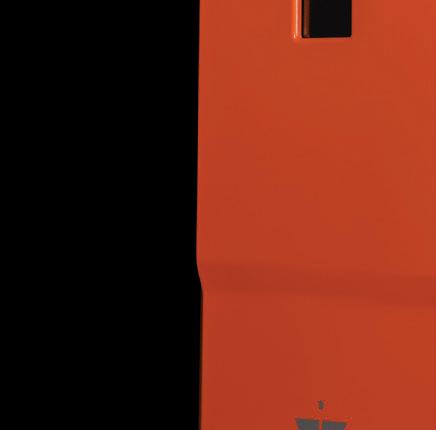




Rising interest rates, bank branch closures, and increased labor costs are creating a slew of problems for restaurants in the year to come. Here’s how technology can keep restaurants more productive and reduce the overall impact of the below challenges:
Rates are higher than ever and are predicted to increase until 2025. This has caused higher costs associated with the supply chain, including the food, equipment, and funding restaurants need to operate. These higher interest rates have also slowed mergers and acquisitions and made business investments more costly. Lastly, businesses try to make cash deposits daily so they can access 100 percent of their sales. This is where a solution like SafePoint, which offers provisional credit, is more valuable to restaurants than ever. They’ll receive daily provisional credit from their bank without having a manager leave the store premise and lose valuable time and productivity—which is already a strained resource.

Restaurants will be facing more challenges when it comes to labor in 2023. Yes, wages will rise. Yes, turnover will continue, and yes, replacing employees will only get more difficult and expensive. Rewards Network reports that the hospitality industry’s turnover rate is 73 percent, and the average cost associated with replacing an employee is $5,864 per person, not including salary. When looking at the numbers, it is no wonder restaurants are turning to automation for repetitive, low-value tasks to reduce costs and boost efficiency with the knowledge that not all employees will be replaced. Automating cash management with a solution like Loomis’ line of Titan smart safes, which automatically counts cash and keeps it secure until an armored truck picks it up, saving managers 45 minutes to an hour and a half daily.
Banks continue to close branches especially in rural and suburban areas. Managers are now driving further to make deposits and get change which means they are out of the store for longer periods when labor is tight and in-store operations must take precedence. Reducing bank trips leaves more cash in the store, increasing risk of loss and decreasing cash liquidity for the business. In addition, banks are raising fees to help streamline their operations, and commercial businesses are being heavily impacted. Many restaurants have reported the fees associated with over-the-counter deposits rising as much as 50–200 percent.
While not all these problems can be easily solved, restaurants can alleviate some of the impact of these challenges by investing in the right automation technology that reduces the need and cost of labor, eliminates bank trips, and subdues the higher costs associated with high-interest rates. RET
To learn more, visit loomis.us.
rates add financial and labor strain, but restaurants can reduce the impact.
›
›
›
›
› Enterprise-wide reporting

› Receive daily provisional credit


› Eliminate bank trips


› Keep funds safe

With inflation at historically high rates, restaurants are struggling to rein in operating costs. Concurrently, they are also dealing with a massive labor shortage and the unpredictable work ethic of Gen Z employees. “Countless customers we’ve surveyed brought up the difficulty of onboarding new workers, only for
In California, measure AB 257, which sets the minimum wage for fast food workers at chains with more than 100 restaurants to $22 an hour beginning in 2023, is expected to have huge ramifications, and not just for the larger chains that meet that criteria. “I spoke to several independent restaurant owners who were concerned their workers won’t stick around when they can get paid more at these chains,” Park says. “Taking wage competition into account, that’s $45,000 or more per worker every year, which is around the cost of three of our robots. Our robots are essentially free labor after that first year.”
Serving robots from Navia Robotics come with multiple trays and a plethora of smart sensors to avoid obstacles. Bellabot, a customer favorite, can carry 90 pounds of food on four trays in one go—the equivalent of three human workers in a footprint of just 22 inches in diameter. They have better consistency and repeatability than robots from other companies, positioning to within four inches of its designated location and navigating aisles as narrow as 21.5 inches on some models.
them to provide no notice when sick or just ghosting altogether,” says David Park, director of sales at Navia Robotics, a company with extensive experience deploying robotics solutions to combat the rising costs and the labor shortage pervasive in the food service industry.

“Even restaurants that aren’t experiencing a labor shortage have substantial labor inefficiencies,” Park says. “They have enough workers to cover the peak times, but during off-peak hours, a substantial proportion of the workers are sitting idle. Our robots are designed to bridge the gap in this imbalance.”
The response from restaurants that have deployed serving robots have been resoundingly positive. The robots do what they do best: running food, escorting guests, or bussing dishes to designated stations. That frees up workers to do what robots cannot possibly replace; providing human interaction with guests. The robots free up time and energy for workers so they can stay in the dining area to quickly respond to the needs of customers. They can also deliver hot dishes and soups safely, drastically cutting the risk of burns for both workers and guests.
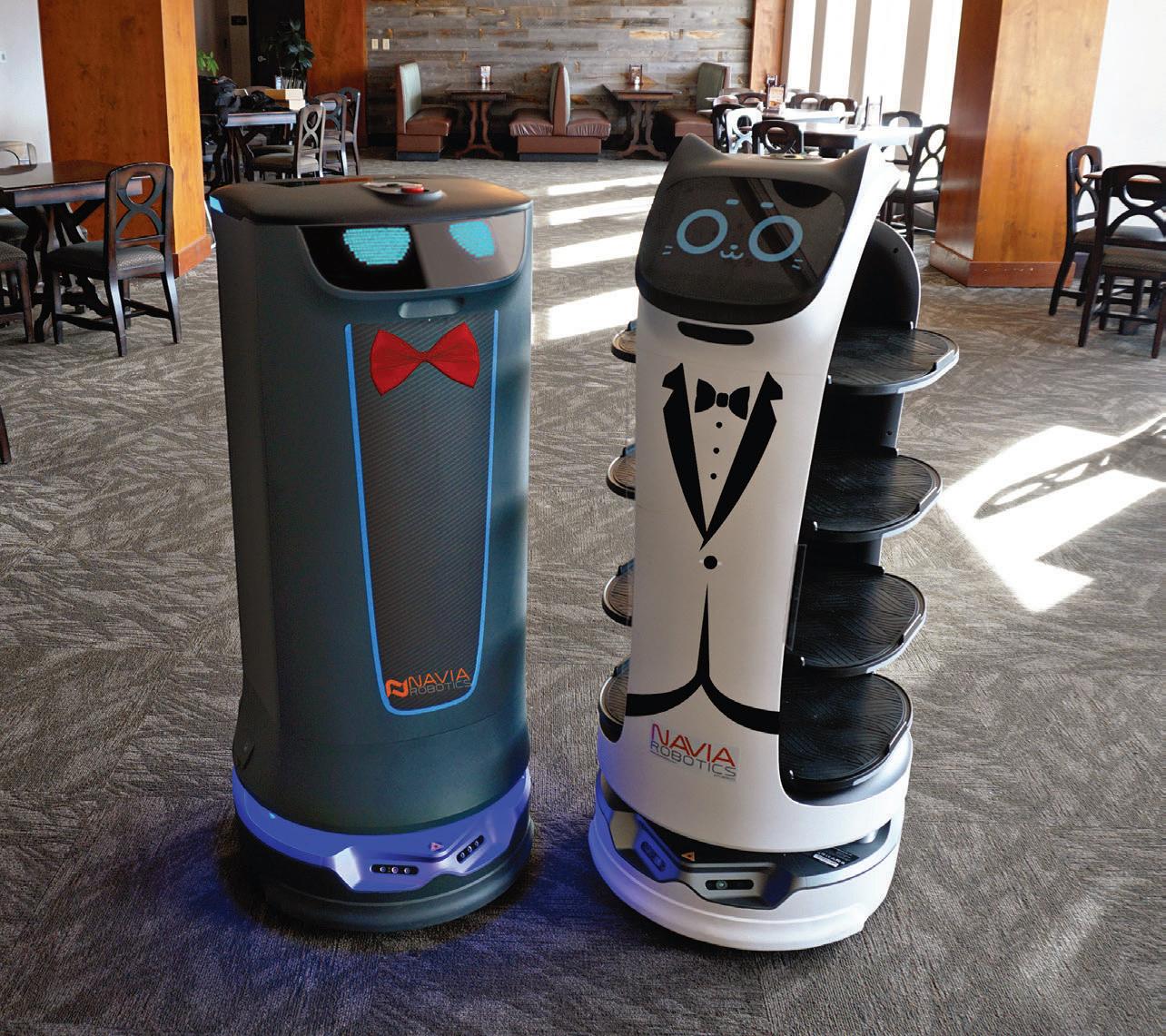
Other nice features include a birthday mode to provide a fun ambiance for celebratory guests. Watch a robot come to a patron’s table as guests take pictures and upload videos on social media, providing brand awareness and free marketing. “Robots are here to stay,” says Peter Kim, chief technology officer of Navia Robotics. “The sooner you adapt to deploy them in your operation, the better prepared you are for the future. We’re here to make that transition as smooth as possible.” RET
To learn more, visit naviarobotics.com.
Consistent. Affordable. Reliable.

•
No sick days, no holidays, ready to work any time, 24/7/365.
• High capacity, quick reflexes
Carries heavy and dangerous loads without bumping into obstacles.
• Low cost, zero maintenance
Reduce your labor costs while improving service and attracting customers.

scan for more info

See why thousands of restaurants are partnering with Navia Robotics, the most trusted service robotics company to deploy robots in their operations. Don’t be left behind in the automation technology that is revolutionizing the food service industry!



On September 5, 2022, the Fast Food Accountability and Standards Recovery Act ( better known as the FAST Recovery Act ), was signed into law. Under the new law, the minimum wage for California fast-food workers could increase by 41 percent—from $15–$22 per hour—in 2023.
The law will have a significant impact on the nearly 15,000 franchisees in California—and likely restaurants in and outside of California in the not-too-distant future—compounding the challenges they already face. Commodity inflation, increased labor costs, labor shortages, and supply chain disruptions are already putting pressure on restaurant profitability.
“With rising costs, operators have had to hike prices to maintain margins—but there is only so much room left to do that,” says Carlos Benavides, national account manager at Restaurant Technologies. With the new law, the International Franchise Association warns that food prices could rise as much as 20 percent. “For many diners, there simply isn’t wiggle room left in their budgets to dine out.”
With such competitive wages, there is less staff loyalty, and workers are more likely to leave for a job that pays more. Without enough workers, chains with extended hours may not be able to staff shifts adequately, forcing them to sacrifice revenues from one or more dayparts.
For operators facing staff shortages and increasing labor costs, automation is critical. One of the most strategic decisions they can make is to automate manual tasks and reallocate labor to guestfacing, revenue-generating roles. Using automation to maximize the efficiency of the existing labor pool, managers can work with smaller crews.
“Manual cooking oil handling is truly one of the worst jobs in the kitchen,” Benavides says. “Employees are lifting heavy jugs of oil and moving hot oil from the fryers to rendering tanks—both of which have potential for injuries. Total Oil Management, our end-to-end oil management system, eliminates all of that.”
Another Restaurant Technologies solution, AutoMist®,
automatically keeps hoods and flues clean, eliminating grease buildup—and the potential for a catastrophic fire. When restaurant operators create a safer work environment with fewer injuries and workers’ comp claims, they might qualify for insurance premium credits.
“Insurance companies look at restaurants with our solutions in place and reward them with insurance premium credits,” Benavides says. “Operators can unlock valuable savings—especially in California where a 5-percent reduction in premiums is a significantly lower expense.”
Automating onerous back-of-house tasks has numerous benefits for restaurant operators. Not only can labor be reallocated to guest-facing tasks where a human element is needed, it creates a safer environment. And staff loyalty is boosted by eliminating manual oil handling, which is arguably the worst and most dangerous job in the kitchen.

“In the face of a national minimum wage increase, our solutions save operators money,” Benavides says. “With these innovative tools, they can offset labor costs and subsidize any type of incremental spend.” RET
To learn more, visit rti-inc.com.
In an already-strained labor environment, operators look to automation to increase profitability.
Manual cooking oil handling and hood cleaning are labor-intensive and expensive.
Restaurant Technologies automates and simplifies back-of-house processes with hassle-free cooking oil and clean hood solutions.

Get end-to-end cooking oil management and automated hood cleaning with no upfront costs.
Learn more at www.rti-inc.com
are customized to fit a restaurant brand or franchisee group’s needs and priced accordingly.
“Our repair programs provide customers peace of mind,” says Steve Symonanis, vice president of marketing with R.F. Technologies, Inc. “The programs offer customized coverage that fit the specific need for the number of locations and equipment you have.”
Another reason Symonanis believes interest in repair plans has gone up is due to the increased
demand in the drive-thru space. That demand makes it more critical than ever to make sure equipment is up and running.

It was
While drivethru traffic at most quick-service restaurants remained sky high, various other factors threw wrenches in what may have otherwise been a home run of a year for many brands—inflated prices, labor costs, as well as other looming side effects stemming from the pandemic created massive headaches across the industry.
With so many costs and expenditures out of their control, some operators began to invest in solutions that would offer some semblance of predictability. For example, repair plans offer an efficient and cost-effective option to help ensure equipment is always up and running.
R.F. Technologies, Inc., a drive-thru headset repair company with five service centers across the country, has seen an increase in quick-service locations and franchisee groups using their repair programs for these very reasons. R.F. Technologies’ repair plans
“Staffing is always an issue in the quick-service restaurant industry, but that’s especially true now,” Symonanis says. “You might have store owners or managers working the register or working on the grill. That really makes it difficult to train everyone on how to properly use and take care of the equipment, which, in turn, can cause an increase in needed repairs.”
Equipment repaired by R.F. Technologies, Inc. is completed and shipped back to the restaurant location in 24 hours of it being received at one of the company’s five locations. Operators needing equipment repairs—whether on a repair program or not—can go to the company’s website, rfdrivethru.com, to get a free shipping label to use to send in their damaged equipment. The labels are automatically addressed to the nearest R.F. Technologies, Inc. location to help provide for the fastest turnaround time.
“This is our core competency,” Symonanis says. “We understand that operators don’t have time to be waiting around for equipment—they need it yesterday. That’s how we conduct our business. We have been working with restaurant operators for over 30 years, acting as a lifeline for over 150,000 quick-service restaurants during that time.” RET
For more information, visit rfdrivethru.com.
How headset maintenance can become a controllable expense.
“ The programs offer customized coverage that fit the specific need for the number of locations and equipment you have.”







With ever-evolving operational challenges, it’s never been more important to ensure every kitchen benefits from the latest tech-led solutions. With the right technology in place, brands can manage numerous mounting pressures, from cost increases and staff shortages to supply constraints.
Welbilt’s KitchenConnect is an open-cloud solution which is supported by the largest ecosystem in the foodservice industry - combining strength in numbers with industry-leading expertise. Before meeting the key players in the KitchenConnect ecosystem, explore why Welbilt has the edge in this space.
The foodservice industry is in the midst of the largest digital transformation in history – and Welbilt was first to recognize a need to evolve beyond the common controllers included with traditional equipment. Ease-of-use is an important factor in design and drives efficiency, however harnessing equipment which is connected drives more efficiency while reducing resources. This is critical as staff can focus on what is most important – the customer experience.
Welbilt’s Born Digital strategy helped cultivate products that were plug-and-play for connectivity. Keeping that model in mind, connecting beyond equipment became central to maximizing a kitchen’s efficiency.
Enter: KitchenConnect, the only culinary focused platform that can be remotely monitored, controlled, and adapted to a brand’s kitchen. It reduces operational costs, increases equipment uptime, and enhances food safety. KitchenConnect’s ecosystem is powered by the biggest digital companies in the Internet of Things (iot) space that will empower Welbilt’s homegrown cloud platform to deliver the ultimate connected restaurant environment for brands.
AT&T provides a global cellular service complete with a professional service team for restaurant connectivity set up. Its SmartHub edge connects all equipment in the restaurant to KitchenConnect. Next up, Bruviti serves an AI-powered customerservice triage and parts-prediction platform for KitchenConnect that delivers superior aftermarket service so operators have the peace of mind and time to focus on the customer.
Best-in-class digital transformation expertise is provided by HCL to integrate end-to-end technologies including cloud, IoT, AI, analytics, and cybersecurity on Welbilt’s unique platform. Microsoft delivers secure edge infrastructure with Azure Sphere and hosts KitchenConnect on the Azure IoT platform for critical insights into kitchen operations.

To fine-tune operations, KitchenConnect is enhanced by Perfect Company to deliver a best-in-class Kitchen Crew Operating System which eliminates food waste, decreases training time, and increases food quality and speed of service. Last but not least, TeamViewer offers a cutting-edge solution for remote service and augmented reality for KitchenConnect products. This unique technology can help reduce training time, simplify repairs, and help self-diagnose issues as they come available for both repairers or kitchen operators—all designed to help increase uptime of equipment.
Working seamlessly together to power KitchenConnect, these best-in-class technology companies deliver complementary and much-needed digital solutions to brands at the highest standard. RET





























The drive thru has long been the lifeblood of the quick-service industry, but the pandemic helped refocus the attention of consumers and operators alike on the importance of an efficient drive-thru operation. Anything that helps speed up transactions, increase order accuracy, and help brands create a better experience for their customers has mutual benefit to quick-service brands and their loyal followers.
Xenial (pronounced zee-nee-ul) is a single technology platform that offers “end-to-end, enterprise-ready restaurant solutions, customer engagement tools, and global reach,” says Tracy Gallimore, vice president of sales with Xenial.
“While others have been talking about the ‘drive-thru of the future,’ we’ve been building it,” Gallimore says. “Xenial Next-Gen Drive-Thru gives restaurants full visibility into their growing drive-thru channel, along with an integrated set of tools to drive sales. It’s all powered by our patent-pending Next-Gen Drive-Thru Controller, which can give brands a return on investment in as little as nine months.”
According to Gallimore, here’s how Xenial’s Next-Gen DriveThru Controller can help restaurants increase velocity and sales within a drive thru.

The system helps capture speed of service metrics in any facet of an operation’s drive thru with a timer system that is powered by cameras and artificial intelligence (ai). Xenial’s clients reduce drive-thru times by about 12 seconds or more when leveraging the company’s technology.
Additionally, brands can manage rising labor costs and address labor shortages with the system’s voice assistant ( “bot” ) -driven ordering and self-service kiosks, helping replace manual labor once done by employees.
Restaurants enjoy an increase in average check size using AI-driven automated upselling, along with bright, engaging displays that help connect the brand to its consumers. Xenial’s clients report a 2.5 percent boost in overall sales and 2 percent increase in both LTO and combomeal upsells.
The payment process can be simplified and sped up by using QR codes that help drive the customer to an online payment platform.
Xenial’s Next-Gen Drive-Thru Controller helps unite an ecosystem of products under its platform, including AI-enabled voice ordering, a recommendation engine, and camerabased timer, along with ports for drive-thru hardware, such as base station, mic, speaker, and OCU.
“With over 30 years of experience, Xenial has a direct presence in 62 countries, serving 51,000 locations and another 110,000 cloud merchants, including 20 of the top 50 quick-service brands in the U.S.,” Gallimore says. “Our namesake comes from the Greek word for hospitality and that’s a reference to our obsession to power your enterprise’s hospitality success. We would love to connect with your brand and help introduce our solution for the future of the drive thru.” RET
Operators report a return on investment in as little as nine months after installing this solution.
“While others have been talking about the ‘drive-thru of the future,’ we’ve been building it.”






Coates Group ........................................17 312-374-1365 | CoatesGroup.com
DoorDash ...............................................1 855-554-5779 | get.doordash.com/qsr


Ecolab ....................................Back Cover 800-529-5458 | ecolab.com
FatzFoodz .............................................8 202-840-8958 | fatzfoodzrunners.com
FIFO Innovations .................................39 800-453-3436 | Fifoinnovations.com
Frank’s Red Hot ...................................15 800-322-7742 McCormickForChefs.com/Franks-Means-Buffalo
Ghirardelli ............................Inside Front 800-877-9338 | ghirardelli.com
HungerRush ........................................12 866-766-6799 | pos.hungerrush.com/orderai
InnoPak ...............................................29 800-INNOPAK | innopak.com

NAFEM Show ........................................45 thenafemshow.org/register
National Sign Systems ............Inside Back 800-544-6726 | nationalsignsystems.com
NorthAmerican Bancard .......................49 866-481-4604 | NYNAB.com

Red Gold .........................................11, 19 866-729-7187 redgoldfoodservice.com/sample-requests
RF Technologies ..........................7, 33, 72 800-598-2370 | rfdrivethru.com









ShiftPixy ................................................2 888-798-9100 | shiftpixy.com

Texas Pete .............................................5 Texaspete.com
Transact Technologies ..........................35 877-748-4222 | transact-tech.com/qsr-mag
Vito Fryfilter ........................................43 847-859-0398 | vitofryfilter.com
Worcester ............................................47 800-533-5711 | Shortening-Shuttle.com

LEADERS IN QUICK SERVICE .............................20-23




| fioruccifoods.com






























